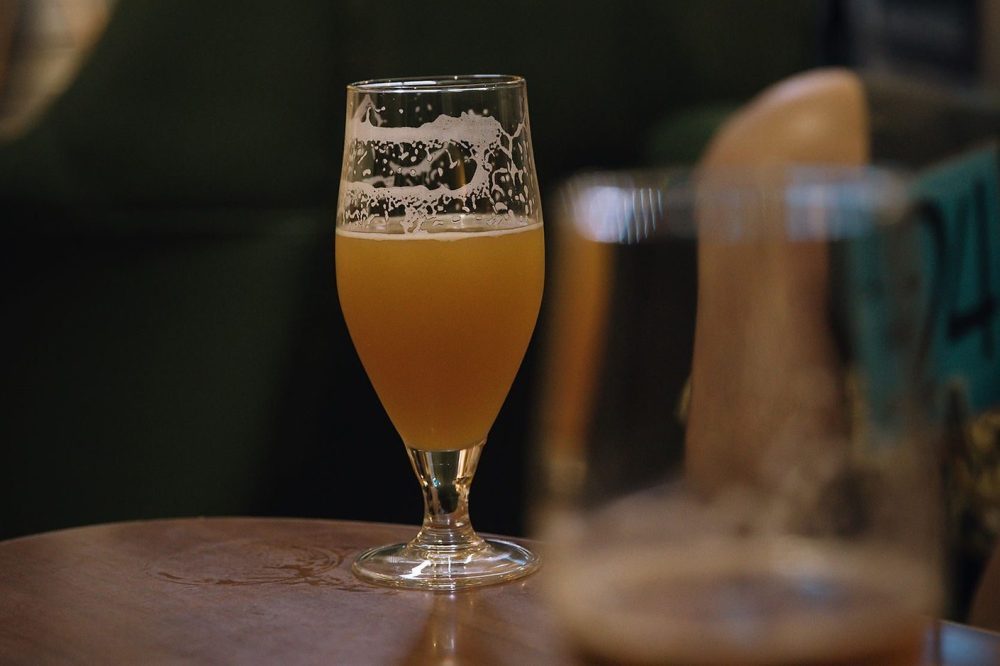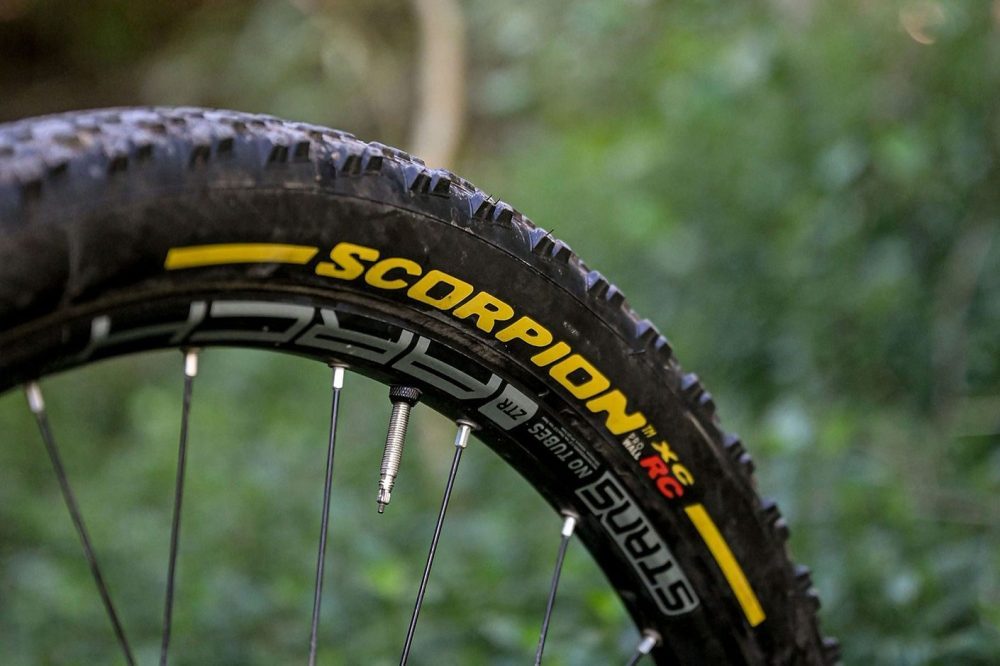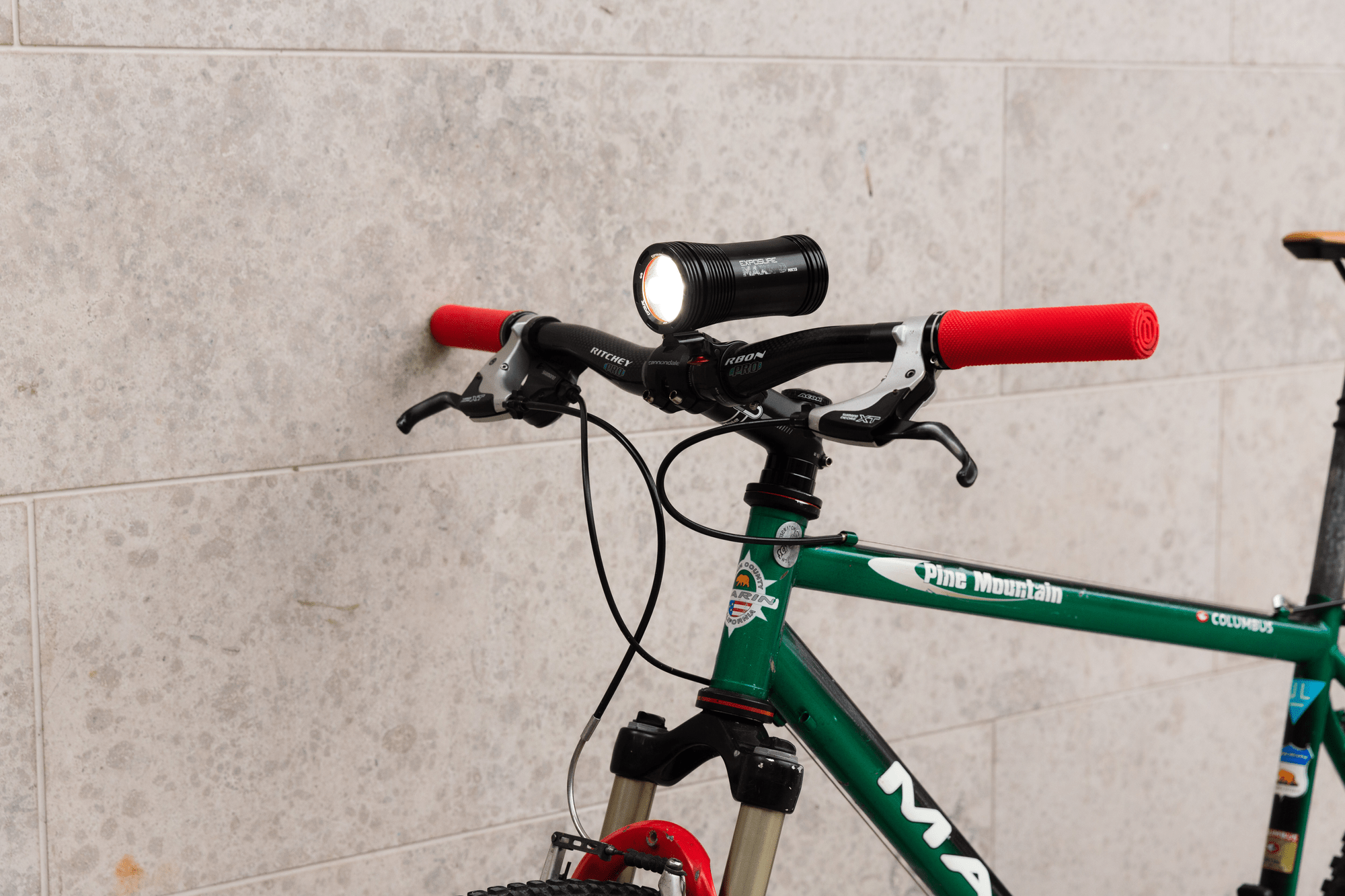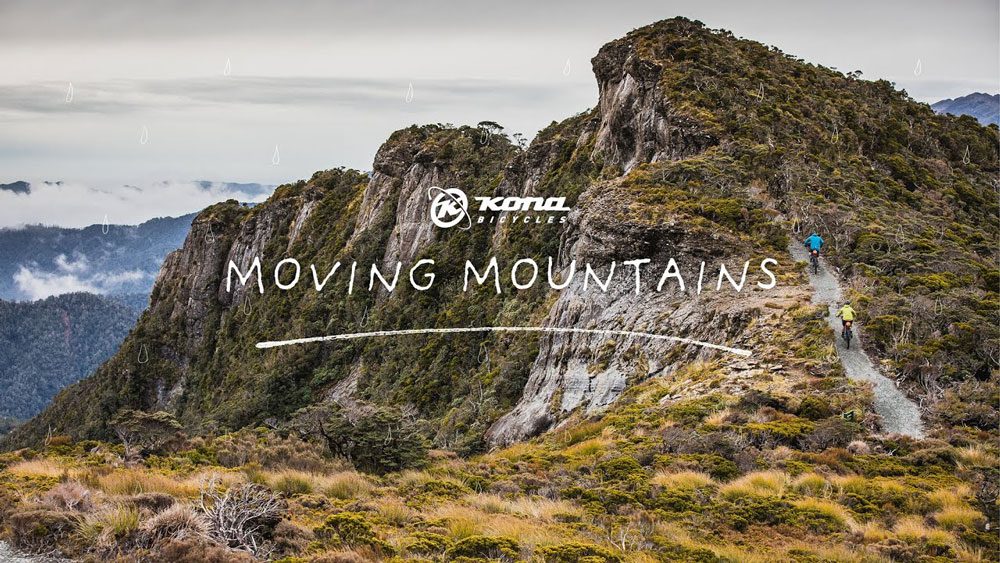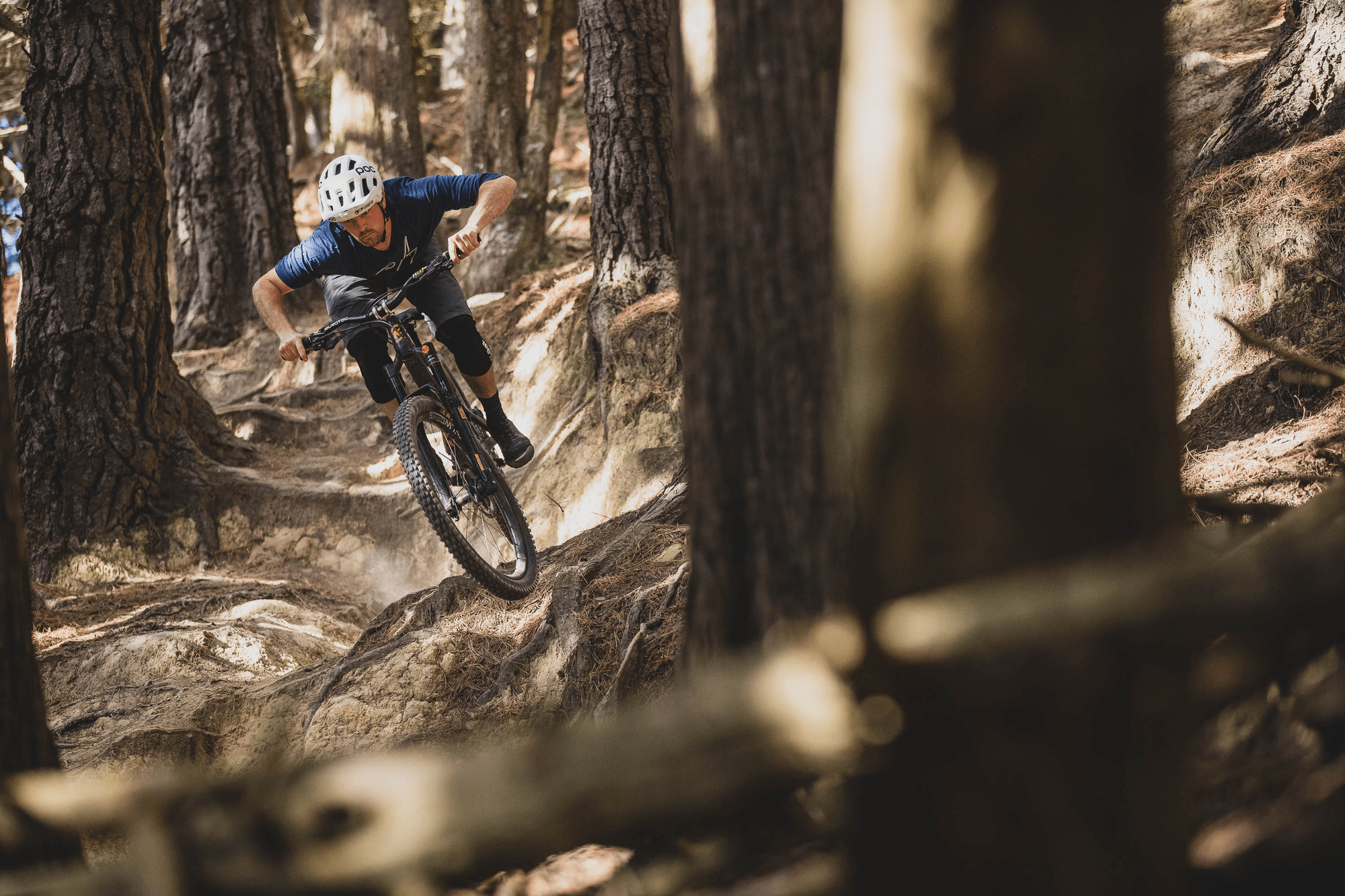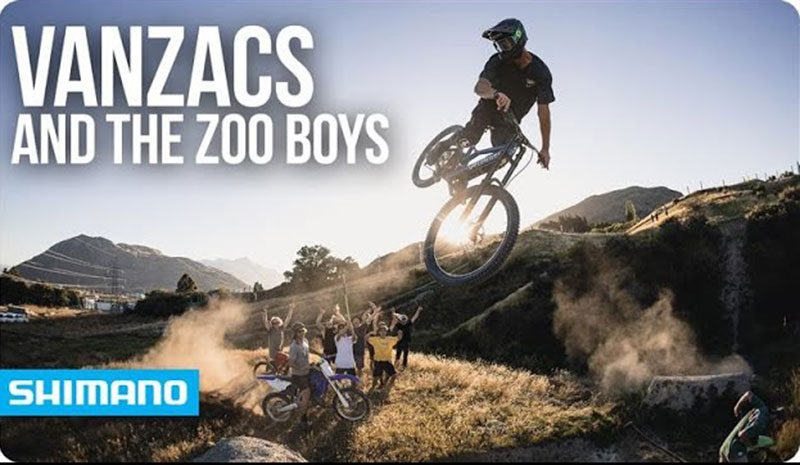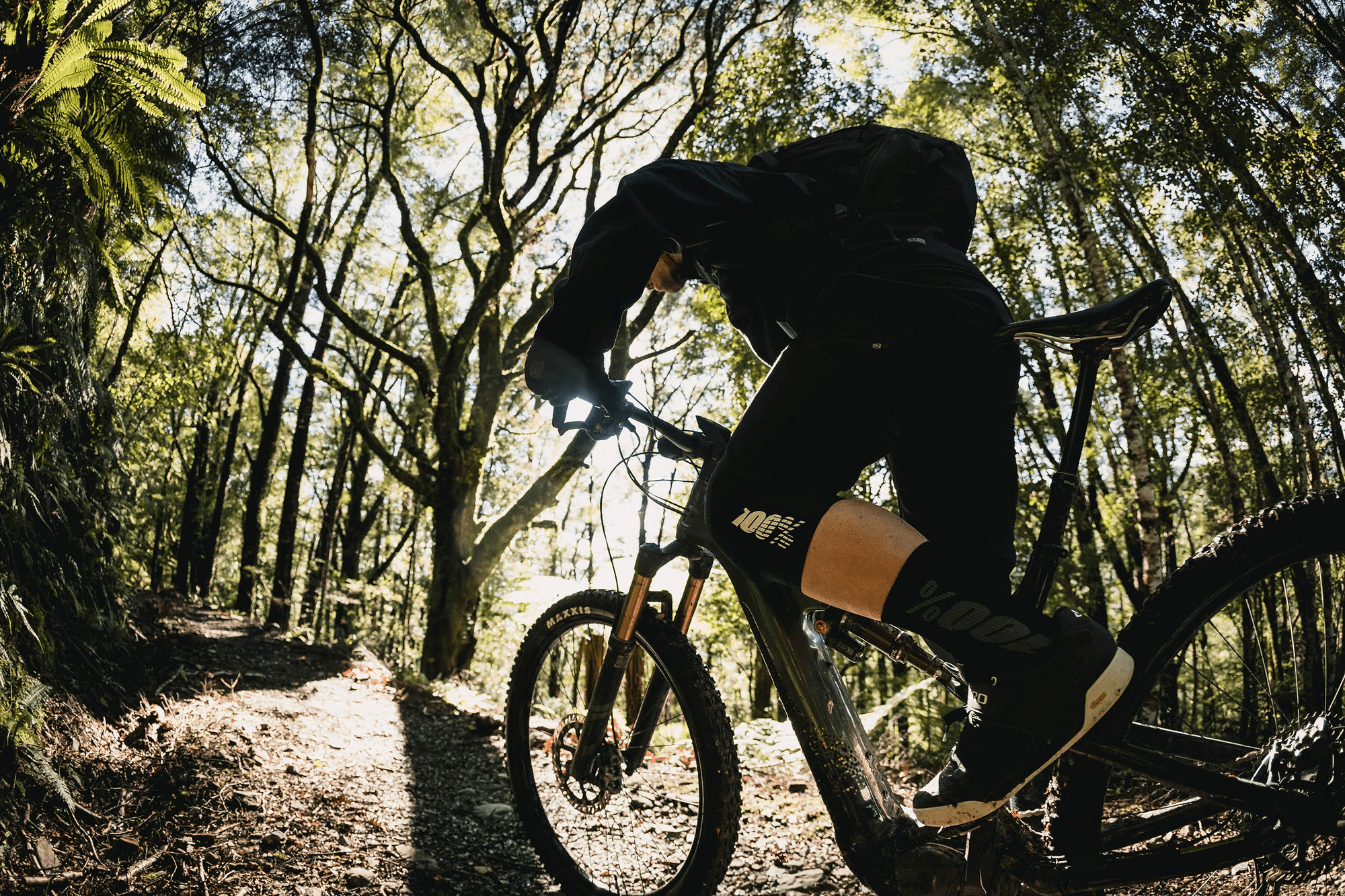Review: 100% Teratec Plus Elbow Pads
“I managed to avoid hitting any trees with my elbows, but with these on, I’m kind of tempted to give one a nudge anyway.”
Buying elbow pads is a bit like buying health insurance; you probably don’t really want to spend your money on it but, the moment you need it, you’re sure glad you did. 100% have a massive array of mountain bike specific protection on offer now, with four unique ranges depending on whether you like the full-on Iron Man level of protection, or something more understated that would fit in well at your local yoga class. Somewhere in the middle of all this is the Teratec+ range, and I’ve been putting the Teratec+ elbow pads through their paces for a few months now.
The Teratec+ are a full-sleeve style elbow pad. There are no straps or Velcro, just a stretchy mesh on the inner forearm and padding on the outer. The elbow pad is naturally curved, articulating just above the elbow which means that it moves nicely with your arm, without any pinching or bunching.
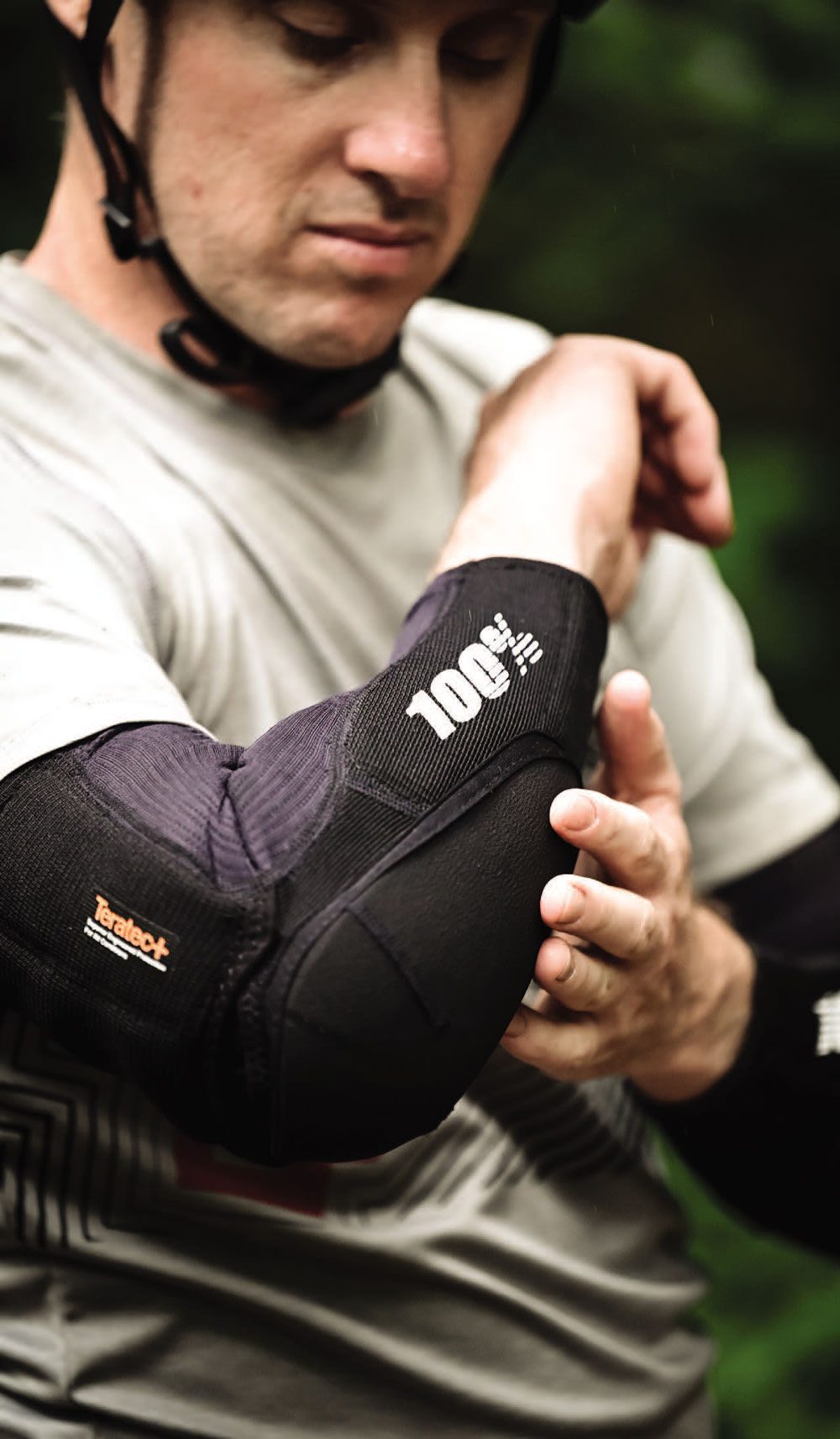
The main padding on the elbow and forearm feels a little like the G-Form style soft, putty-like, slow- rebounding material. Extensive googling couldn’t help me find out anything more about this but suffice to say, it feels sufficiently thick to stop the hardest of impacts.
Above and below the main line of elbow padding is a thinner foam pad, extending the protected area around your forearm as well as up and around the triceps area.
They feel like the most coverage and protection you can reasonably expect from an elbow pad that doesn’t utilise a hard plastic shell. Personally, I prefer pads without the hard shell as they seem to still offer ample protection for 99% of the scuffs that my elbows face, and get the benefit of increased flexibility and ability to form to your arm. There is also a band of silicone grip at the upper cuff to stop them sliding around.
On the trail the Teratec+ elbow pads felt great. The bend in the elbow feels just right and, after a few moments, I tended to forget they were even there – ideal really! The full-sleeve style is undoubtedly a hotter style pad than something that is really only covering a protruding elbow, but it does give a boosted sense of confidence on the trails. Riding in the spring and autumn, when temperatures are just a little bit cooler and the trails a bit more slippery, I think I would find myself wearing these frequently. The sleeve style helps them stay in place and they do a great job of not budging – even over the roughest terrain – without feeling restrictive. As luck would have it, I managed to actually avoid hitting any trees with my elbows during the review period but, with these on, I’m kind of tempted to give one a nudge anyway.
REVIEW: LANCE PILBROW
DISTRIBUTOR: FE SPORTS
RRP:$139
Feature: From Birth to Evolution
Four Forty Mountain Bike Park enters its sixth season of operation in 2021.
Back in November 2014, backing onto the Hunua Ranges just south of Auckland, in a previously little-known part of the North Island (for most serious mountain bike trail connoisseurs), Four Forty Mountain Bike Park opened to the public for the very first time. Fast forward to October 2021 and the park is entering its seventh season of full commercial operation.
The project, originally headed by Byron Scott and Aaron Tait – before Byron bought out his business partner in 2017 – has seen many iterations. Most recently, there has been trail work completed by Trailpro and sizable investments made in park infrastructure, in preparation for this coming season. In recent years, the park has been through its most visible changes largely due to pine harvesting, as the park operations are undertaken on a fully operational forestry block.
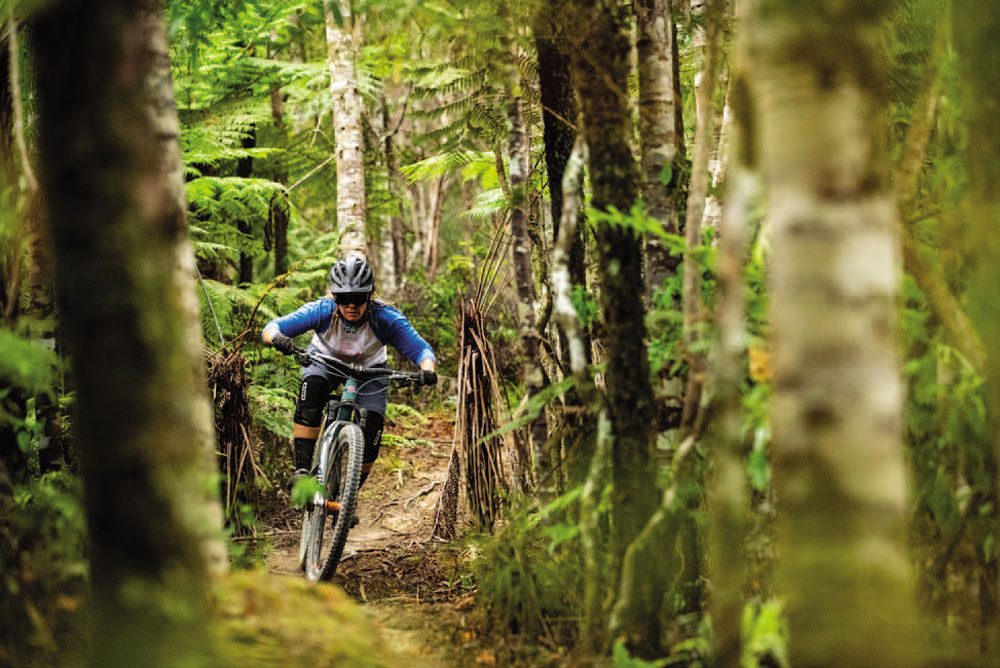
Not to worry – there is still plenty of lush native forest and pines to accommodate your party in the woods. Due to clear felling in sections of the park in the winter of 2019, several of the original trails have been fully rebuilt including Pretty Fly which, overlooking the Hauraki Gulf and the Firth of Thames, surely has the most spectacular jump lines in New Zealand.
Park developments are not limited to the trails. This season, substantial investment has been made at the base area. Previously, the park ticketing office, retail, workshop and bike rental was all run out of several well-dressed containers. What was a little too rustic to be safe for public use, the sheep shearing shed has been replaced by a much more permanent 150m2 building, including an office and retail space larger in size than most dedicated urban retail spaces. The character of the old sheep shearing HQ has been thoughtfully maintained, with a nod to the land’s previous commercial uses. This asset signals the permeance of the park and Byron’s intention to continue to improve all aspects of the customer experience. Surrounding the base building, over 4000 native plants have been placed as evidence of the thought and care that has gone into all aspects of the park’s current existence.
It has been no easy feat to reach this level of development in just six years with nothing but private investment from Byron himself, and with support from enthusiastic landowners who allow this activity to take place on a fully operational forestry block. It has been Byron’s enthusiasm for mountain biking, quality trails and seeing diehard customers return to the park to ride year after year that has fueled the efforts required to open and operate the park each season. In the early years, customers trickled though the gates and many issues with the management and operation of the shuttle vehicles put barriers in the way of consistent growth in the business. But, having spent so much time and personal money on the venture – to the point that Byron’s perseverance, coupled with a will to solve or work around issues that arose, is what eventually pushed the operation through the challenging startup years. Byron compares the journey to a crawl across the desert; “you are halfway across the desert – what do you do?”. It is this bullish approach, combined with Byron’s creative problem solving, that results in an approach to life and business for him that most would shy away from.
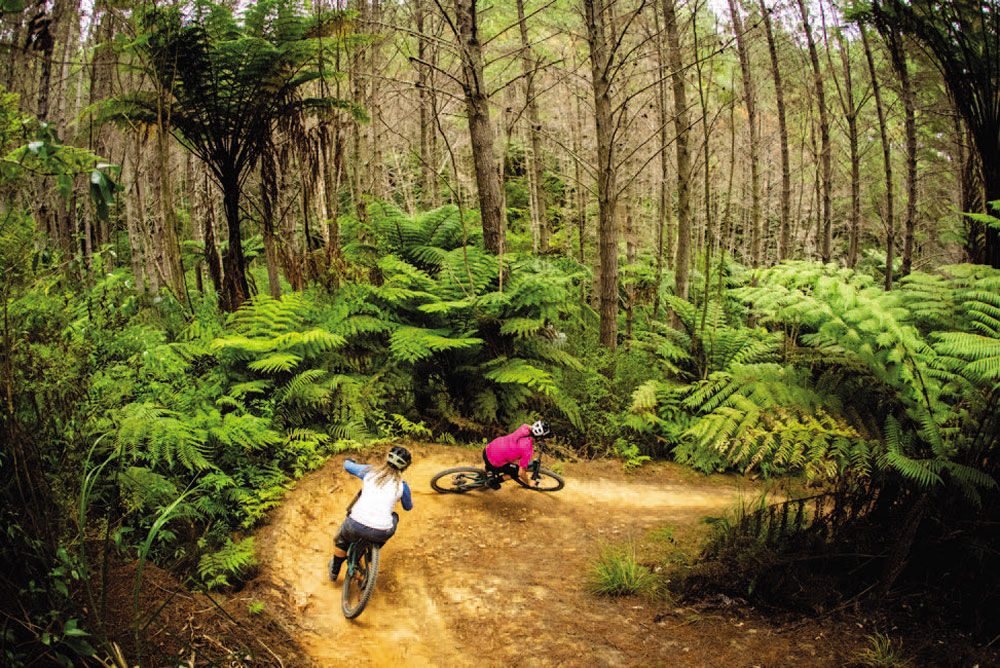
Once the formal years had been navigated, the key to the park’s growth — which has enabled the continued development towards entering this next phase for the business – has been the trail quality. When the park first went into operation, there was just six km’s of trail. Today, 22km of trail exists in the park, with a variety of trail styles and grades - the quality of which is rivaled by few commercial bike parks globally. The attention to detail in the construction of the trails – and, as a result, the ride experience for the customer – can only be described as a true feeling of flow. This is what keeps the core local and regional customers coming back and is now starting to attract users from an increasingly wider geographical area.
From narrow, off camber hand cut lines and a national downhill racetrack, to fast flowing digger- built lines and flowing jump lines, the park has evolved significantly. In the context of running a commercially sustainable bike park, it’s not just the trails alone that contribute to the overall experience of the customers; Byron believes this is the single largest contributing factor to attracting repeat business.
It’s not just the quality of the trails that bring riders from far and wide; Four Forty has been home to a swathe of national and regional events since day one, including Auckland Downhill Champs, National Cross Country and Downhill Series rounds, the annual 440 Gravity Enduro, National Secondary Schools champs and, of course, none other than the Dodzy Memorial Enduro.
The kickoff to the 2021 / 2022 season was delayed due to the recent Covid lock downs. With the park fully polished and ready for opening in September the momentum of park trail crew, and staff had to be redirected temporarily.
In true 440 spirit the situation was managed, plans were changed, and they made the best of the situation by distracting themselves and their customers by posting humorous content to their social media channels and by building their new fleet of Transition rental bikes.
The park was finally able to open for the season on the 10th of November albeit at reduced capacity to comply with current operational restrictions. Needless to say, the staff are happy to serve the customers and the customers are happy to be back riding at one of the best niche gravity riding locations New Zealand has to offer.
• Located a leisurely 50 minute drive directly east of Auckland Airport – or rather, 2 hours 45 from Redwoods – Whakarewarewa Forest, Rotorua – for the mountain bikers of New Zealand.
Words: Cam Cole
Photography: Sven Martin
Review: Trek 2022 Top Fuel
“The Trek 2022 Top Fuel responds really well to rider input and, as a result, is simply really fast.”
The process of evolution involves a series of natural changes that cause species to arise, adapt to the environment and, sometimes, to become extinct. From walking on two legs to riding bikes and now having the ability to ride bikes off cliffs at Redbull Rampage shows how far we’ve come!
Just like us, bikes tend to evolve too; the Top Fuel we’ve had on review for the last two months is a perfect example of that. Previously Trek’s XC race bike that evolved into a marathon bike, it has evolved again, and Trek fans might be wondering just what exactly the new Top Fuel is now?
Trek’s Supercaliber, with exclusive IsoStrut shock, 60mm of travel and unique pivotless seatstays, sits in the XC race seat the Top Fuel used to occupy in Trek’s stable. This has given the Top Fuel the opportunity to evolve out of that same XC space into something new, and that’s exactly what it has done.
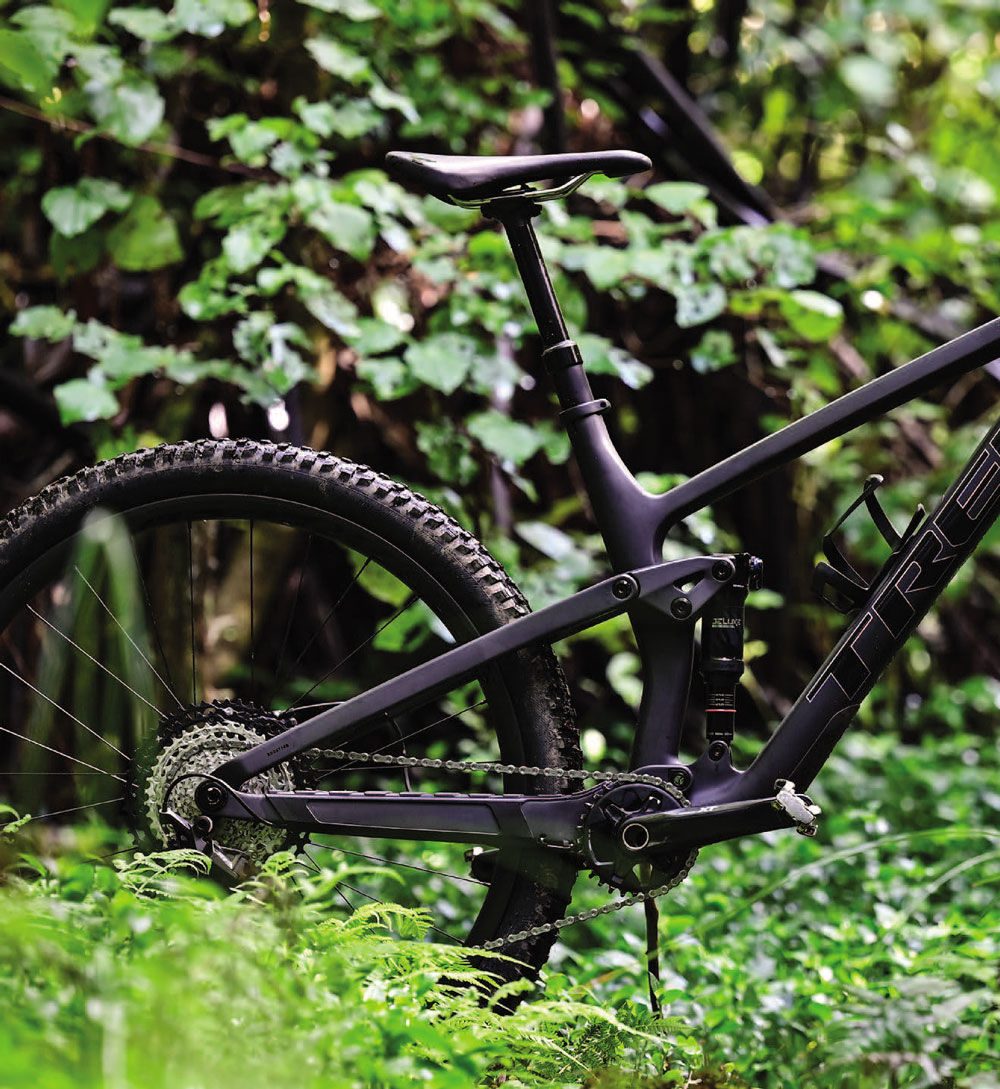
So, is it a ‘trail bike’? Is it a ‘down country bike’? Or is it just what we also thought a ‘mountain bike’ was?
Previous Top Fuel fans might even be asking, ‘has it evolved too far?’
In New Zealand, the Top Fuel will be available at eight price points. As mentioned, we’ve had the 9.8 XT model, worth $8849, but it’s also available in two alloy models which offer the most affordable entry points; the Top Fuel 5 at $3799. Entry into the carbon options is the 9.7 ($6599), going all the way up to 9.9 XX1 AXS Project One, for $15,449.
So, what are the key changes that have been made in the process of evolution? For 2022, travel in the rear ups from 115mm to 120mm.
To be fair, 5mm extra travel isn’t really much of a game-changer but upping to 120mm sends a signal that this isn’t, in fact, a slightly evolved XC bike – this is definitely an all-new Top Fuel. Making all that 120mm of travel work, is Trek’s ABP rear pivot system.
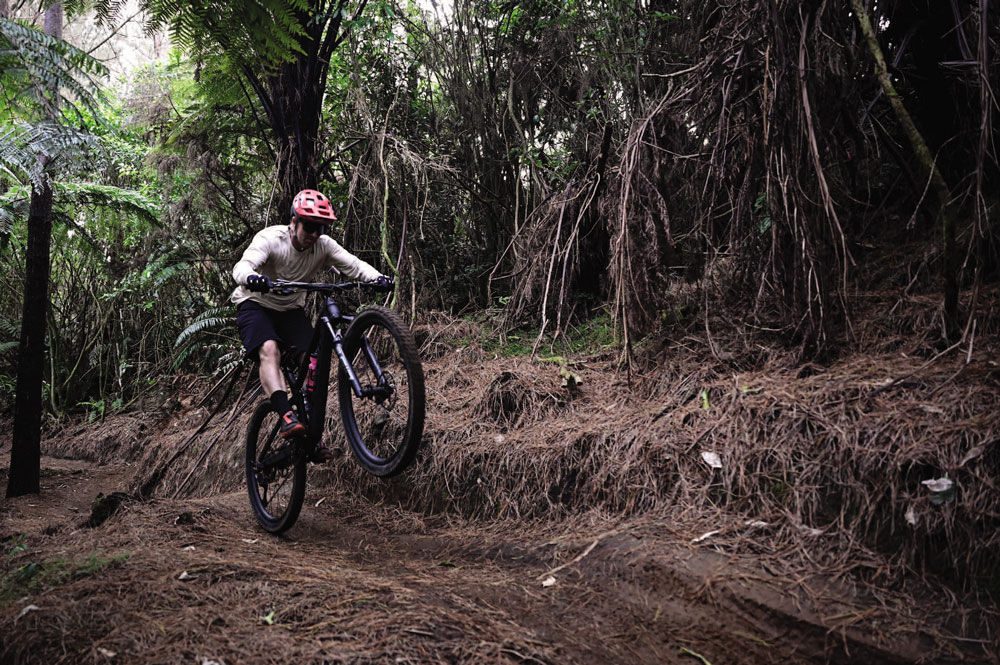
We’ve always been a fan of this system – the rear axle pivot rotates directly around the axle point, and this allows Trek to tune how the suspension reacts to acceleration and braking forces independently.
At the lower shock mount, Trek’s flip chip style geometry adjustment, the Mino Link, lets you fine tune your frame geometry ‘on the go’.
In reality, it’s not likely you’d be doing that out on the trail but in the comfort of your garage, where you aren’t worried about losing precious shock hardware in the dirt, you can flip the Mino Link. Stay in low for a slack 66-degree headtube angle. Flip it for a quicker 66.5-degree headtube angle and a 7mm higher bottom bracket for more ground clearance. All of that is driving the RockShox Deluxe Ultimate RCT shock.
Up front sees the new Rock Shox Sid Select+ 120mm fork. At upward of $8800, we’d really love to see the Sid Ultimate, which gets the benefit of the improved Charger Race Day, over the Charger 2 RL that come on the Select+. However, you still get the full carbon OCLV frame along with Bontrager’s Line Elite carbon wheels, and a full XT build kit from tip to tail, including the superb 4-pot XT calipers and a 10-51 tooth cassette. Everyone seems quite particular about which drivetrain team they are on, so Trek offer their 9.8 and 9.9 models in either SRAM or Shimano build kits.
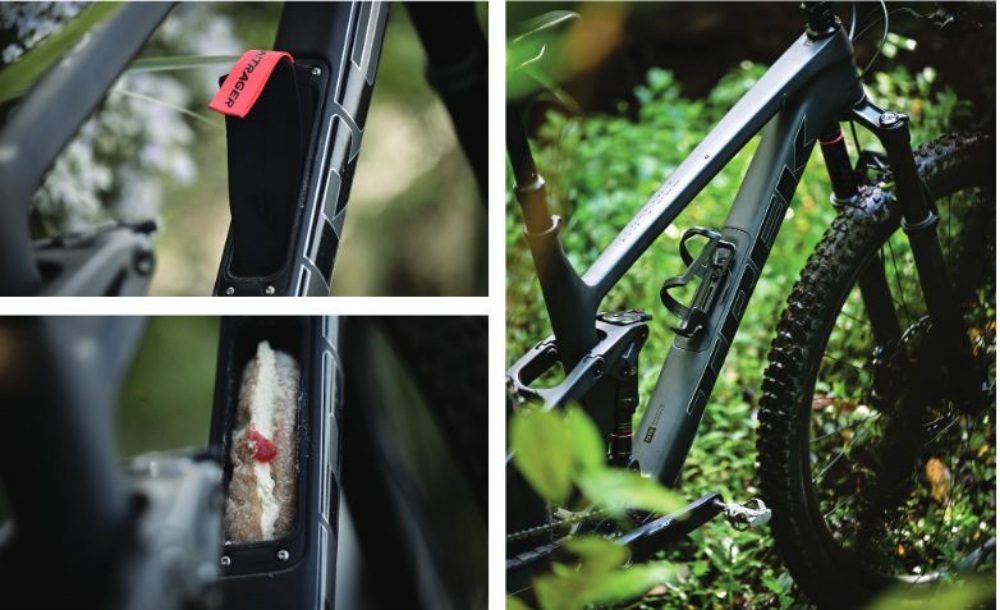
Out of the box, we personally liked the matte carbon look with holographic details around the edge of the logos. It’s subtle, smart and stealthy. This is the cheapest option at the 9.8 spec level. It’s also available in gloss black with a red swingarm, but this is essentially one of their Project One custom paint jobs, and you’ll pay an $1800 premium to get it. That’s some expensive paint.
For us, the pick of the bunch has to be the striking red/purple/yellow fade on the 9.8 GX build. Sadly, that one carries the $1800 paint premium too so will set you back $10,649 total. With all that in mind, the matte carbon XT option looks pretty good. To be fair, the Project One custom paint options that Trek offer are pretty amazing and their paint configurator is also a great way to kill an hour – don’t say we didn’t warn you. It’s cool to see companies allowing this kind of customisation.
All the housing is internal, which completes the sleek look. Your tool kit is also internal! Or it can be, if you want it to be, with a handy tool storage compartment integrated under the bottle cage and a complementary Bontrager Bits pouch to wrap things in. We can now confirm that alongside a small tool kit, you can also squeeze a long cream donut – in case you’re worried about going calorie negative during a ride (who says we don’t do hard-hitting journalism here at NZ Mountain Biker?!).
At the bottom of the down tube there is a plastic armoring to protect the carbon, and a chunky rubberised chain- stay protector to keep things quiet. Trek fans will see the return of the Knock Block, now updated to the Knock Block 2.0, which keeps cables from getting yanked out in a crash and protects the top tube. The only difference being that it now provides an improved 72-degrees of turning radius.
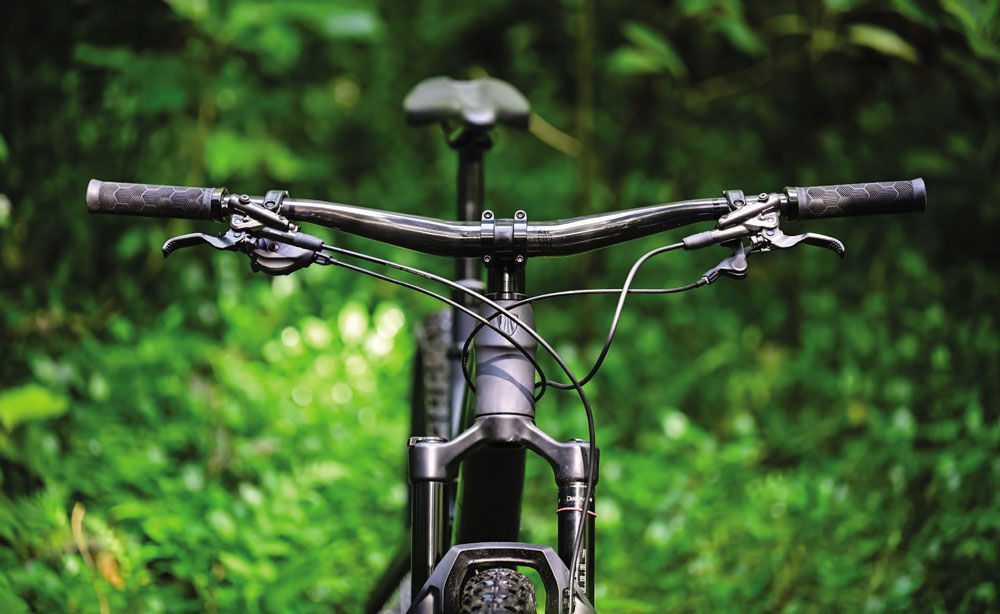
Interestingly, for an XC- ish oriented bike, there is only one bottle cage mount. This seems strange, as this kind of bike seems perfect for longer rides and maybe even marathon races. With 120mm travel, 66.0-degree head angle, and 2.4” tyres, the Top Fuel is set (on paper at least) to be a pretty fun whip and, as we’ve been saying, firmly has its place in the ‘trail’ category. The question Trek buyers might be asking is, ‘is this basically just a new Fuel EX?’ Looking at the numbers, you certainly have to wonder if the difference is big enough? And, if you’re tossing up between the Top Fuel and the Fuel EX, which one should you buy? The Fuel EX is a 130mm travel bike with a 140mm Fox 36 fork. They’ve both got a 66-degree head angle, their wheelbase is almost identical (121.5 for Top Fuel size large, 121.1 for EX) but the reach on the Top Fuel is actually longer (48.0 for the Top Fuel vs 47.0 for the EX). If anything, this probably just signals that the EX is due for a refresh, so we would be surprised if we didn’t see that for 2023, where we expect it will get a similar treatment with a bit more travel and a bit slacker head angle. That will make you wonder if the 150mm Remedy, the last remaining 27.5 wheel bike in the lineup, really has a place any more?
Anyway, all that is Trek’s marketing problems to worry about. Our job is to ride the Top Fuel we have today. Trek describes the Top Fuel as the perfect bike for riders who like to stay pinned both up and down the trail. The term ‘Top Fuel’ is a term associated with American drag racing, which is all about acceleration, so we were expecting this to be a bike that would draw on its XC roots and get up to speed fast – but with modern geometry and tyres that give confidence to push through the corners. Even though we spent two months on it, it didn’t take much riding at all to confirm this indeed lives up to its marketing team’s hype that the “Top Fuel loves to pedal up – lives for challenging descents”. At the end of our review period, we were left thinking, ‘this is the kind of bike a lot of people could be riding’. The Top Fuel gets so much right; the handling is sharp, and the suspension is both active and supportive. It’s the kind of bike that, when you get to the bottom of a rowdy descent and you know you’ve got a decent uphill ahead, you don’t drop your head and wish you were on an e-MTB; instead, you just get on with the pedalling – and might even find you’re kind of enjoying it. Our totally unscientific belief is that, thanks to effective marketing, more riders are riding longer-travelling, heavier, squishier (yes, it’s a technical term) bikes than perhaps the terrain actually requires, and this has really taken the shine off something we are doing a lot of the time, despite what we like to think: riding up hills. Part of this trend to longer travel and overall extra beef, has been about geometry. It has only been longer travel bikes that have had the matching geometry that inspires confidence at speed, or over steep terrain. But, with more modern geometry (read: longer, slacker) trickling into bikes like the Top Fuel, you now have the choice of riding lighter, shorter travel bikes with more confidence over technical terrain. Do you really need 160mm of travel for your everyday ride? Maybe, but probably not. Maybe you’re happy to ride a bike with less travel, but there just haven’t been shorter travel bikes with the corresponding geometry that makes riding downhills a real hoot? This is what the Top Fuel is all about.
Tyre choice can be one of the most significant choices in what terrain a bike will excel on, and with Trek spec-ing the new 2.4” XR4 tyres, they clearly had this in mind. They are noticeably chunkier tyres than you might find on a 120mm travel bike, and probably reflect the kind of personal changes most riders end up making to their bikes in time. The XR4 tyres are worth pausing on for a moment, because they really are a bit of a Goldilocks tyre: not too heavy, not too light – just right. We only mention it because so often tyres seem to just miss the mark. The XR4’s do a great job of hitting just the right balance of speed and control to enable the bike to do what it was designed to do. 2.4” might sound wide but, just like the nation tuning into daily press conferences, it’s the ‘new normal’.
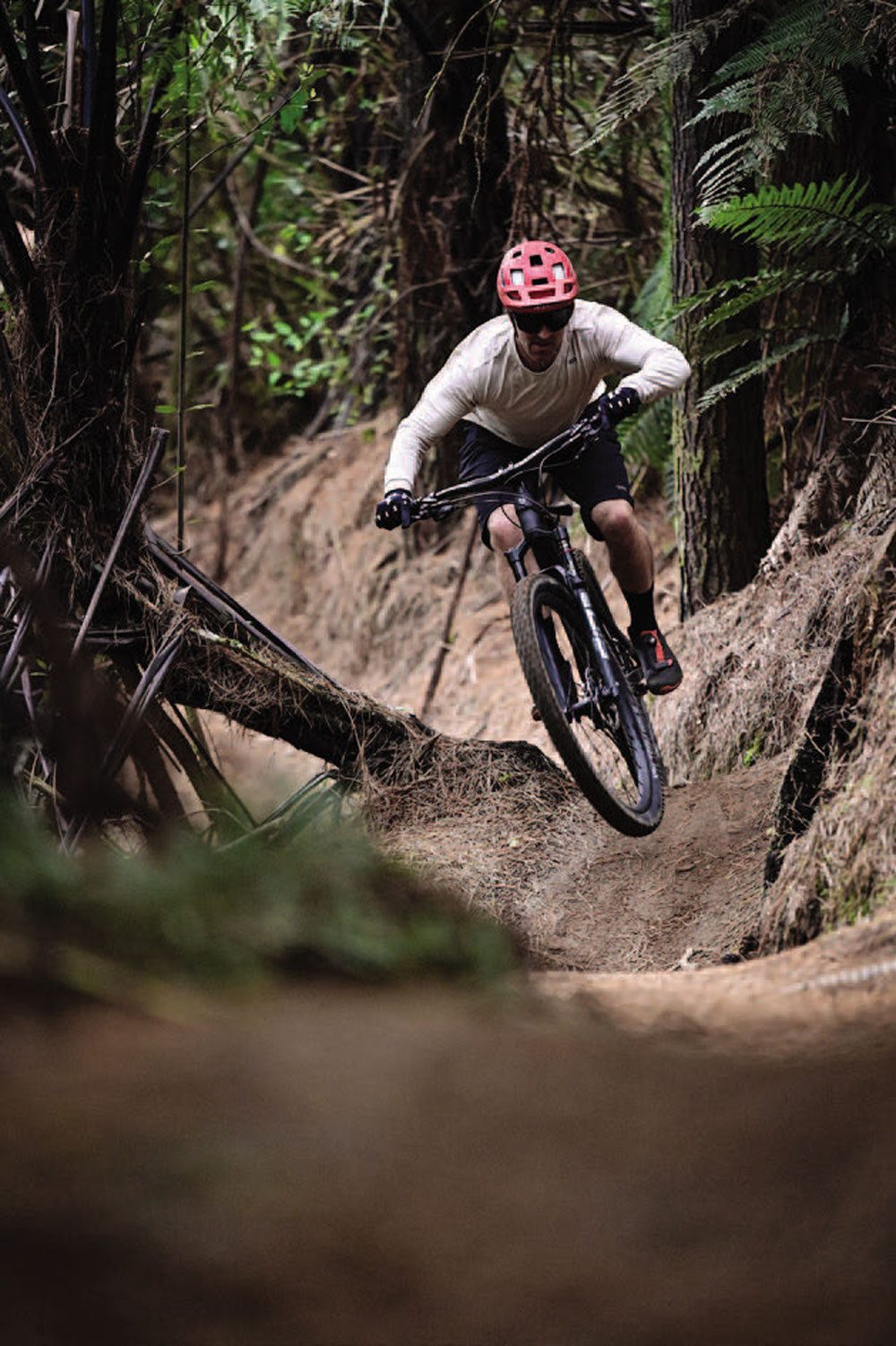
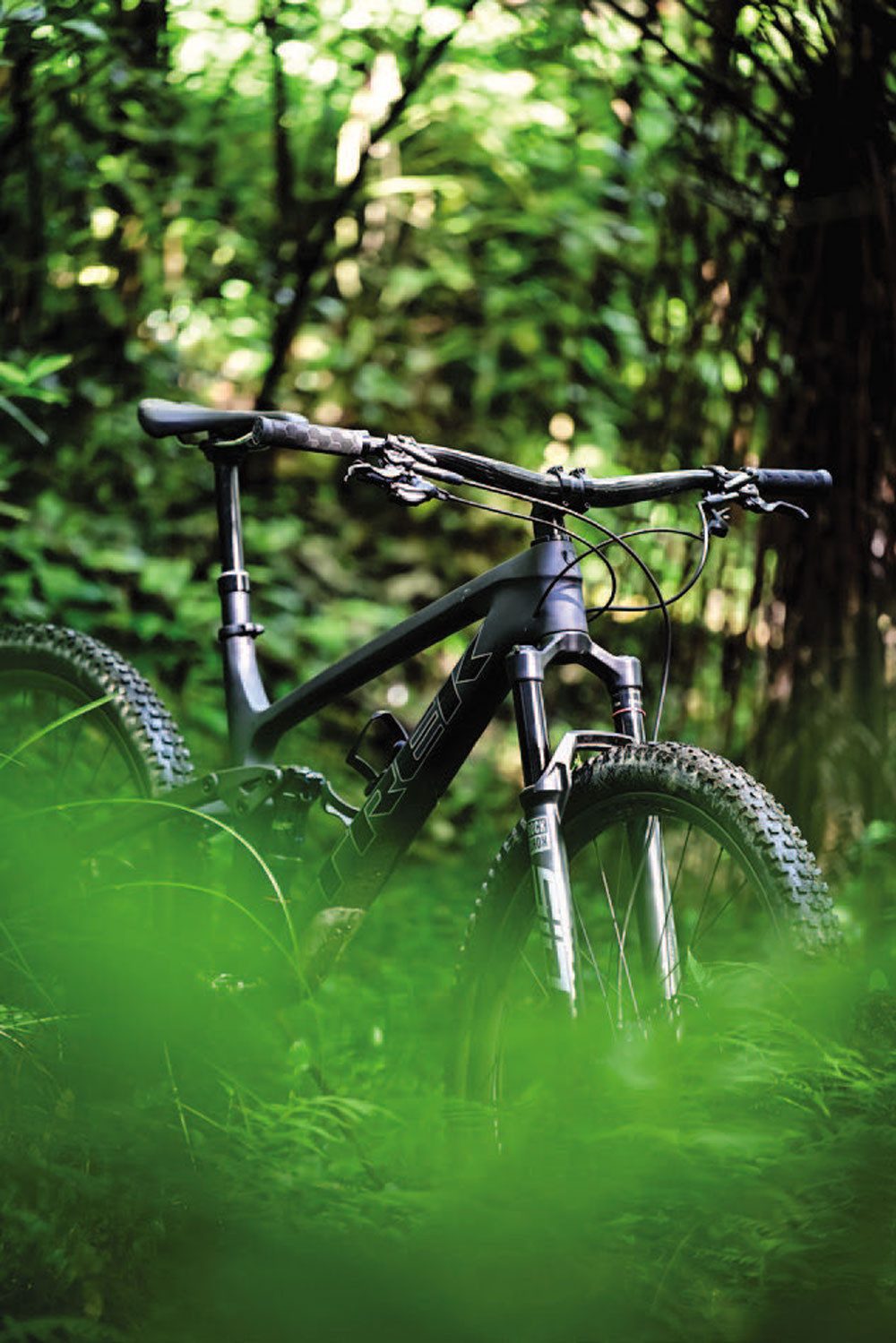
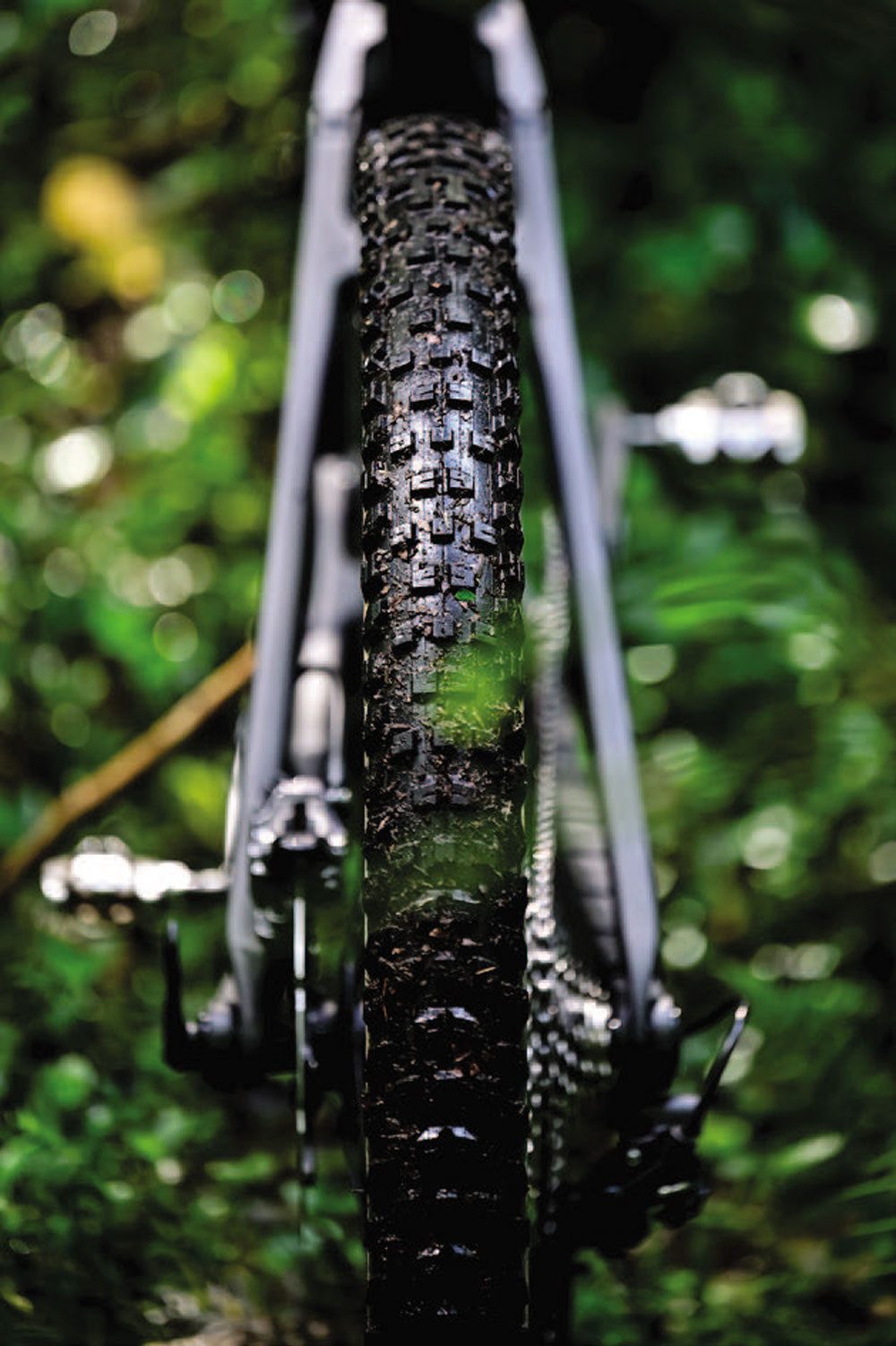
On the suspension front, the Deluxe Ultimate rear shock does a superb job at managing the rear travel through rowdy terrain, however, it does tend to show the limitations of the Select+ front fork. It’s not that the fork is bad – in fact, there is a lot to like – but it has an incredibly light breakaway (to minimise stiction, the SID Select+ is now using Maxima Plush damping fluid and SKF wiper seals) which means it does a superb job at absorbing small trail chatter. But, with only 120mm of travel to work with, mid-stroke damping is critical, and this is where the Select+ can’t keep up. A damper upgrade is around $300-$400, so not insignificant. It’s worth pointing out that upgrading to the SID Ultimate fork is also something you can specify in the Project One bike configurator. Interestingly, Trek say the frame is rated for a 130mm fork as well so, if this was our bike, we’d be seriously considering flicking the fork at the outset and putting that coin towards a Pike Ultimate, which would take the bike a further step away from the XC end of the spectrum. We think this better represents the kind of riding that buyers would be purchasing this for and would make better use of the bike’s capabilities as a whole.
The Bontrager carbon wheelset is worth mentioning. Rolling on the Line Elite rims, they are built from proven OCLV Elite Carbon for an optimized blend of weight, strength, and durability. They held up well during our test. The 108pt engagement freehub delivers rapid pickup at the pedals, but is definitely on the noisier end of the spectrum so you’ll either love it or hate it. There is something kind of obnoxiously satisfying about coasting up behind your riding partner while your freehub is screaming at them, just subtly letting them know that you’re coasting right now and could they please speed up?
The Top Fuel’s strength is that it just does so much of what a lot of us actually do – really well. For a lot of riders, the majority of actual hours spent riding isn’t on either an XC or Enduro race track; it’s probably spent heading out for just a few hours, with a mate or two, once or twice a week. It’s riding a bit of everything; the up and the down – and actually wanting to enjoy both.
It’s not launching five metre gap jumps, but it’s not riding around the one or two metre gap jump either.
It’s the every day, every trail fun that is in the Top Fuel’s sights. It’s responsive, gets up to speed quickly and responds really well to rider input, such as pumping through rollers and, as a result, is simply really fast. It’s fun and efficient at every task and we think it will be a really good fit for a lot of riders. •
REVIEW: LANCE PILBROW
DISTIRIBUTOR: TREKNZ
RRP: $ 8 ,849
Column: Beer Guide
The idea of seasonality in beer is historically driven by necessity. In many European countries, the refreshing, cleansing beer styles were brewed and stored during the colder months, and ready for drinking as the weather warmed up and workers started earning a thirst under the sun. Styles such as Saison and Lambic in Belgium, wheat and lager in Germany, and pilsner in the Czech Republic, all benefited from a long, cool conditioning period over winter. Perhaps the most famous seasonal beer experience, is the annual Oktoberfest in Munich. Curiously, this event started as a celebration of the marriage of the future King Ludwig to Princess Therese of Saxe-Hildburghausen, in 1810. As part of the celebration, a large horse racing carnival was held on October 18 and, for reasons that remain unclear, it was decided to repeat the event the following year which in turn started the Oktoberfest tradition. The horse racing stayed until 1960. Americans have really made a thing about the seasonality of beer, with their pumpkin beers in autumn – related to Halloween – as well as a tradition of strong, sweet and spiced beers at Christmas. In New Zealand, the concept of seasonality didn’t really exist in the era of big brewery dominance, when we got served the same beer all year round.
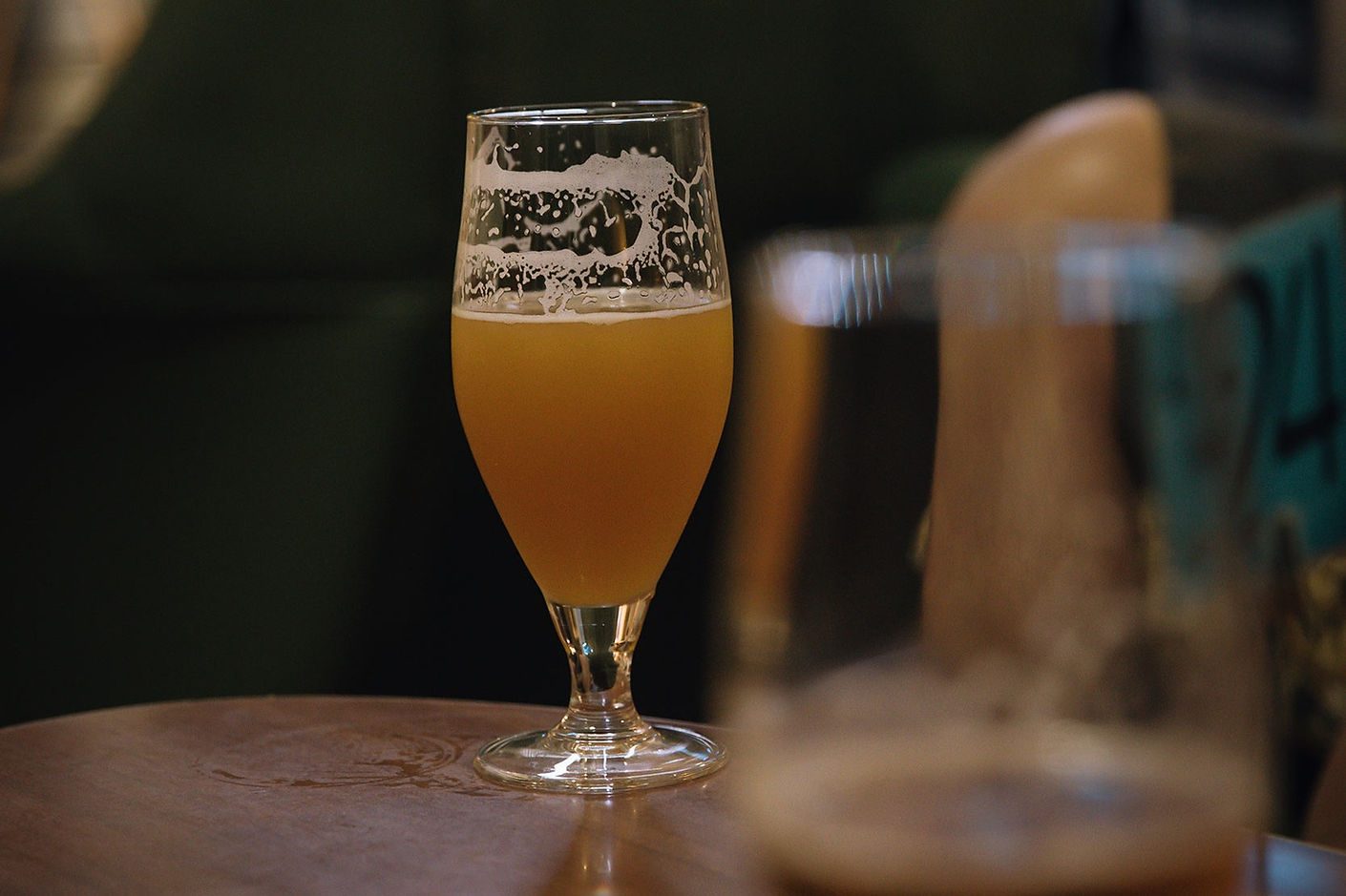
There were small dents in that monoculture; Emerson’s created a Winter Warmer more than 25 years ago - a beer that got reinvented as Taieri George - a spiced ale that’s released annually on March 6, the birthday of the late George Emerson, father of Emerson’s founder Richard. Around 20 years ago, Monteith’s created their ginger-spiced varieties, such Summer Ale, and made a Doppelbock for winter. In recent years, the autumn fresh hop season is fast becoming an integral part of New Zealand’s beer drinking culture, while we’re also seeing more speciality winter ales, such as imperial stouts, Baltic porters and doppelbocks released in winter. The cooler months also see breweries bring out more niche variations of IPA, such as Red IPA and Black IPA. These days, the idea of seasonality has been turbo-charged to the point where breweries make monthly, even weekly, short-term releases. There’s a flip-side to that as well, with many breweries creating annual releases of seasonal-driven beers – usually barrel-aged – with 8 Wired’s cult Feijoa Wild Ale a classic example every winter. In all this, there remains an idea that certain beers are best suited for certain times and climates and dispositions. Most people do not want a 10% imperial stout on a hot summer’s day – that kind of slow sipper does not deliver the level of refreshment required after mowing the lawns in the sun. So, now that spring is with us, there are certain styles of beer that are better suited to days that are drawing out but that are not yet searing hot, when that ice cold lager becomes the first thing you reach for in the fridge. Here’s a mixed six of great spring-time beers:
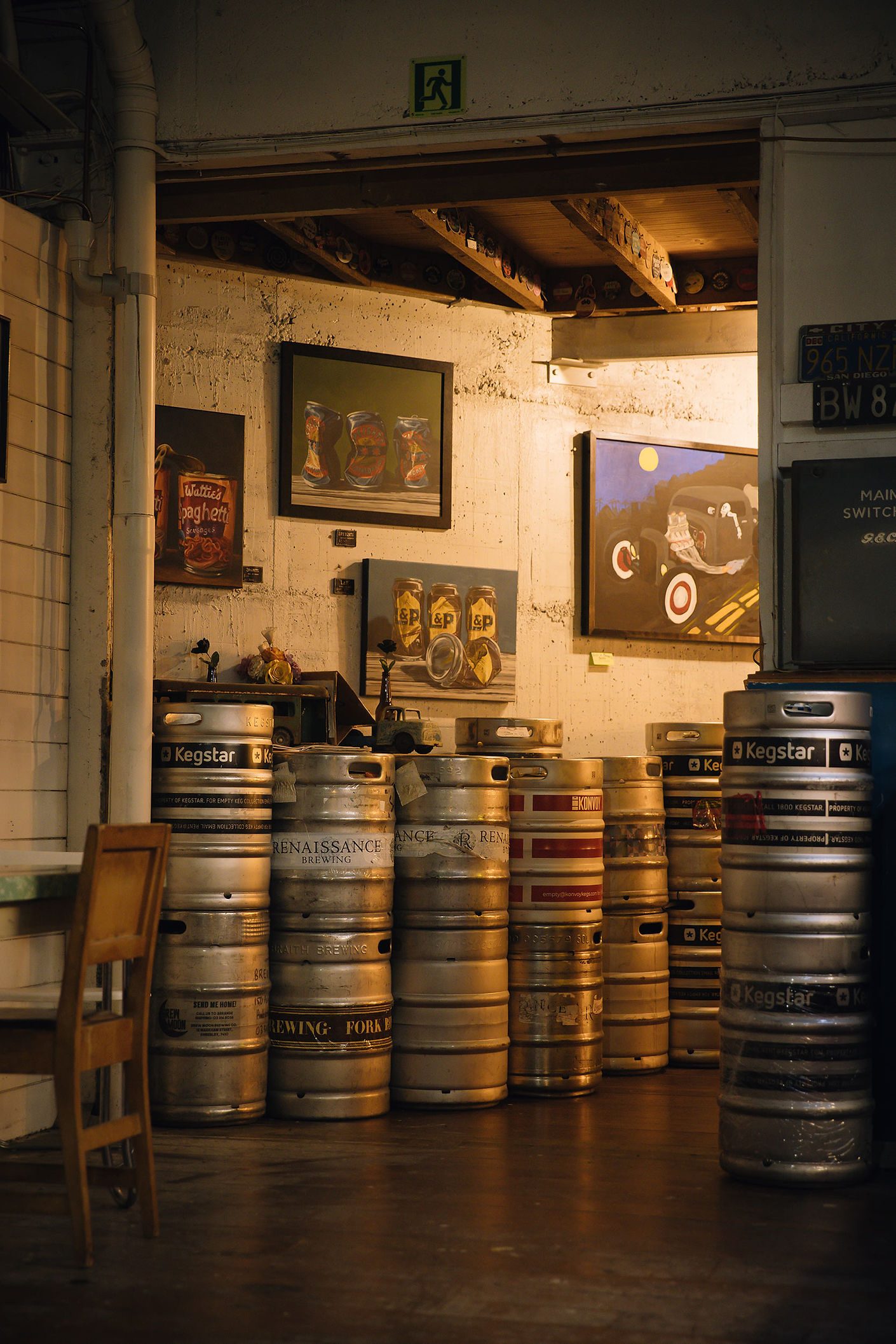
Epic Pilsner
Epic are known for their super-hop forward beers, and when they bring that mentality to a classic pilsner you get some real flavour ‘oomph’. This New Zealand-style pilsner sits somewhere between the traditional Czech pilsner and modern American Pale Ale. It’s lean, crisp and refreshing but with a nice hoppy hit of passionfruit and citrus from the New Zealand grown Riwaka and Pacific Jade hops. Epic don’t brew this beer all year round – and it’s just been released for the daylight saving months.
North End Bines That Bind Us
Saison is the classic seasonal beer – it’s there in the name, after all. Saison is a catch-all descriptor for traditional Belgian farmhouse-brewed ales that were made over winter and ready for the seasonal workers (saisonnieres) when they returned in the warmer months. The beers were partly for refreshment and partly for payment. They are dry, effervescent, spicy and with a perfumed yeast character that delivers an X Factor aroma. North End are one of the best producers of this style and this is a lovely hopped version with a real earthy character.
Sunshine Stockies Session Hazy IPA
Every season is hazy season these days, but when it’s warmer you want something lighter, drier and more refreshing than some of the heavier juice bombs out there. Sunshine, based in Gisborne have absolutely nailed the brief with this 4.2% ABV quaffer that’s jam-packed with guava, mango and white grape flavours. The palate is crisp, extremely fresh and compact.
McLeod’s Great Wave Japanese Dark Lager
A classic Japanese lager is the ideal summer slugger – they are brewed lightweight for easy-drinking. Adding a touch of darker malt, as McLeod’s have done here, doesn’t detract from the easy drinkability but adds a layer of intricate complexity with the subtle hint of cocoa. It’s the perfect season straddler and ideal when you never know what New Zealand’s temperamental spring climate might throw at you.
Sprig + Fern Creme of the Hop Nectaron Pale Ale
Nelson’s Sprig + Fern brewery has gone through a recent rebrand to create a more modern and direct look. And the beer that best encapsulates this new look is their Nectaron-hopped hazy pale ale. This relatively new hop – released last year – is proving a real hit with its pineapple and peach flavours, and this pale ale is a prime example of how to use it in juicy-fruity pale ale.
Altitude Brewing Jam Sessions Vol 3
Altitude Brewing, out of Queenstown, make some of the more interesting beers in New Zealand - but for a long time they were available only locally. Like many breweries hit by Covid-19 lockdowns, they’ve had to step up their online business, which means you can now get their beers delivered to your door. Jam Sessions Vol 3 is their third in a series of fruited sours, and was a huge hit at the recent Beervana festival. Boysenberries, blackberries and raspberries on a soft creamy base creates a fruit smoothie effect. Tart and refreshing – a beersie packed with berries.
Words: Michael Donaldson
Images: Henry Jaine
Review: Pirelli Scorpion XC RC Tyres
Pirelli are one of the world’s biggest names in tyres. You’ll see their logo on the sidewall of F1 cars, rally cars, superbikes and, strangely enough, super boats, such as the America’s Cup Prada Pirelli team. More recently, they have come into the cycling market - though their presence in New Zealand retail cycling shops has been somewhat minimal.
I’ve had the Pirelli Scorpion XC RC tyre on review since summer. The Scorpion is an XC race tyre that we tested in the 29 x 2.2 120TPI Prowall version. It comes in a 2.4 option as well, and a creatively named lighter ‘Lite’ version, which is also a 120 TPI casing. For comparison, our 29 x 2.2 ProWALL weighed in at 650g, whereas the Lite comes in at 610g.
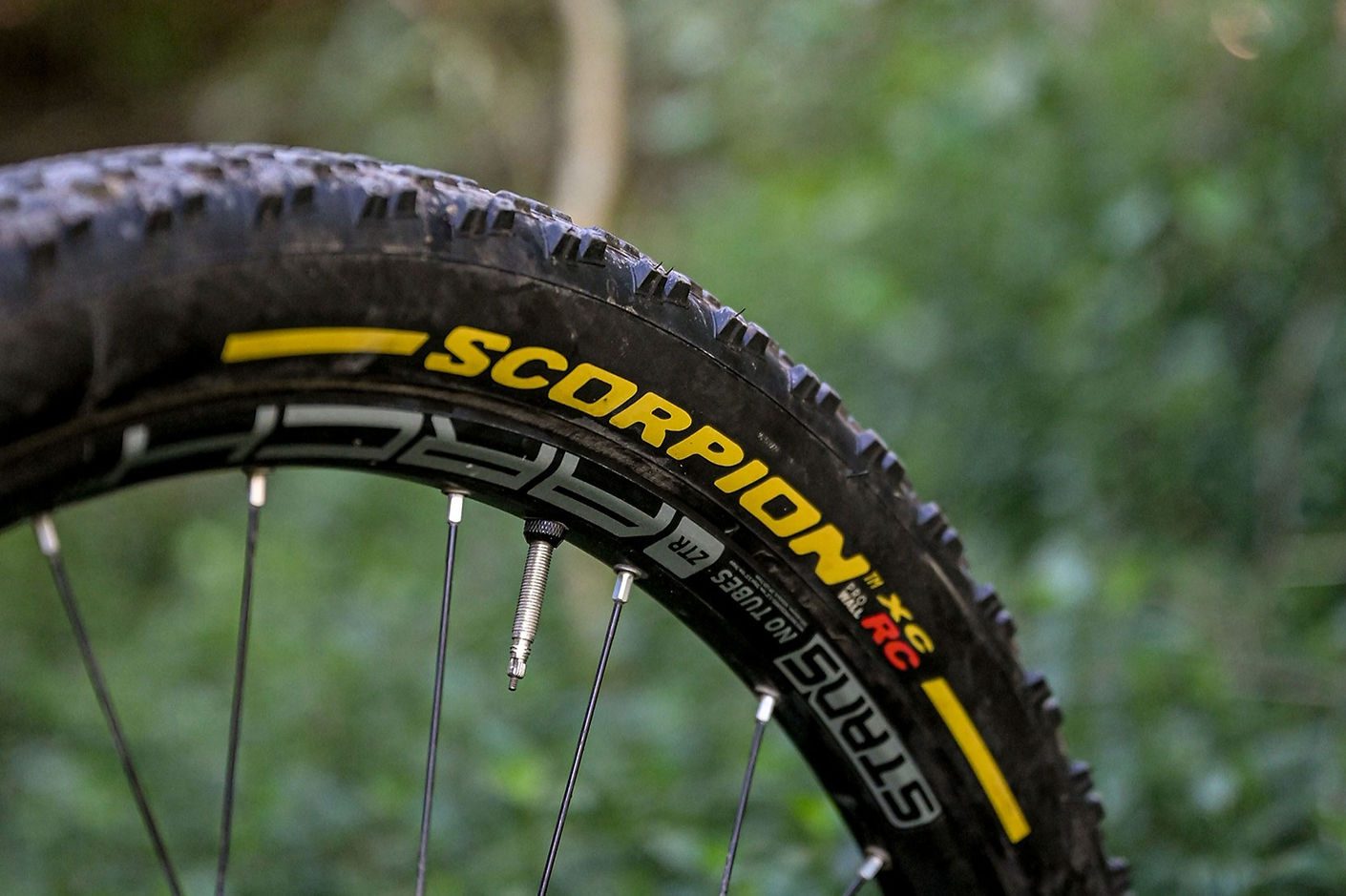
The ProWALL version benefits from sidewall reinforcement technology that increases puncture protection and improves handling at low pressures. Essentially this is an additional layer of nylon fabric applied over the casing sidewalls for extra protection and improved cornering stability. The Lite version omits this, so you save 40g and get a more supple tyre, but you lose some sidewall protection. Both versions roll on the same rubber compound that Pirelli call Smartgrip, designed to provide constant high grip performance in both wet and dry conditions. If the bright yellow Pirelli team logo doesn’t match your bike’s colour scheme, they are also available in a plain black logo too.
A quick look at the tyre and it’s obvious who the target market is for this tyre - Iow profile central knobs offer minimal rolling resistance. The side knobs are still quite decent bits of rubber, though, so I was hopeful this would still be a tyre that gave confidence when pushing through the corners.
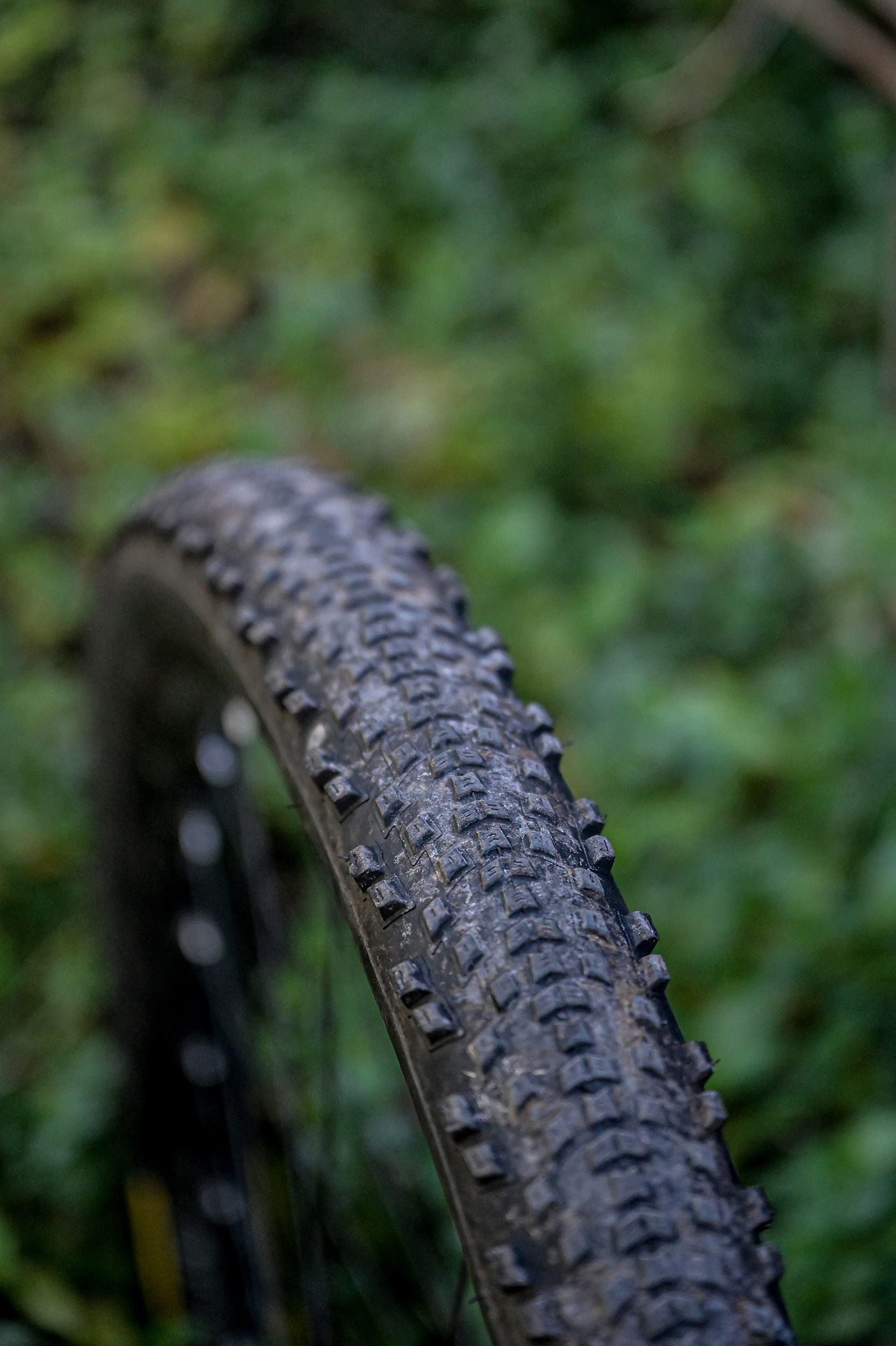
I was pleased to get these tyres a few days before I set out on the 1100km Kopiko Aotearoa bikepacking event, in February this year. I don’t have much interest in XC racing any more, but a lot of the same products - tyres especially - appeal to the bikepacking segment of our sport. I was looking for a lightweight, fast-rolling tyre that was also strong enough to give me confidence when taking them into the remote areas that the Kopiko route followed. The tyres arrived only a few days before I was due to leave, but the tread pattern looked ideal in my eyes, and squeezing and pinching the sidewalls, well, they seemed to be sturdy enough, so on the bike they went and we set off for the East Cape.
One thousand one hundred kilometres later I am really happy with these tyres. They mounted onto the rims incredibly easily, and I had them setup tubeless in no time. Unlike some other tyres, they didn’t seem to leach any sealant and held their set pressure straight away. In fact, over the nine days of riding, I didn’t top up either tyre pressure once. By the time we arrived at Cape Egmont, the rear tyre was showing some obvious sign of wear, but was still well within what I consider acceptable for 1100km of loaded bikepacking. The side walls on the front and rear tyre don’t show any signs of damage which is also encouraging. The Smartgrip compound seemed like an excellent compromise for being fast-rolling on the seal and still grippy enough to ride the more technical parts of the route, such as the Timber Trail, without holding back.
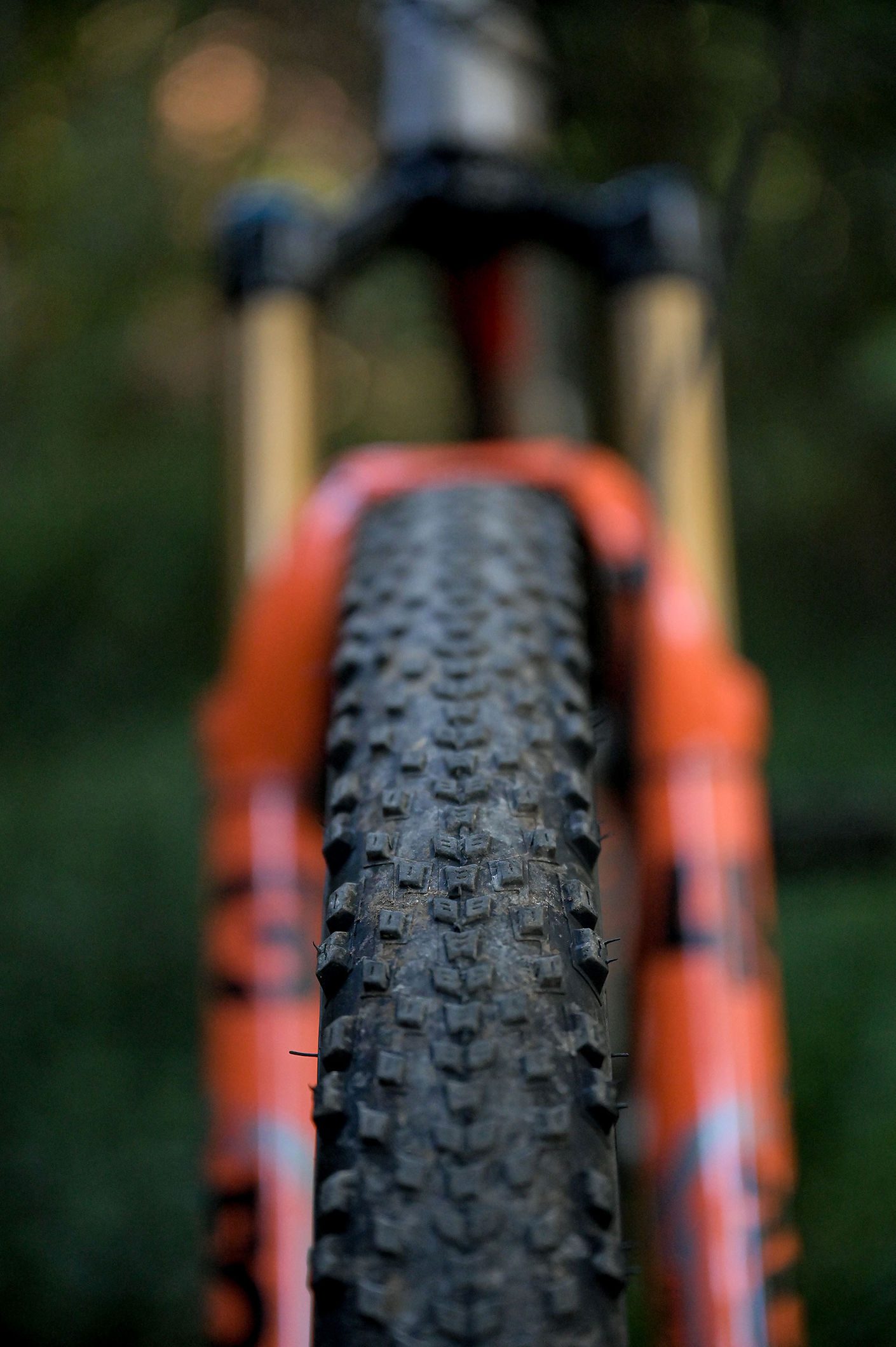
Since then, I have used them for a number of laps around our local mountain bike trails and have been impressed with their ability. Clearly a low profile tyre like this is best suited to dry, hardpack conditions - in the wet, the side knobs still offer control and confidence, however the thin centreline knobs have limited ability to support braking as soon as it gets wet.
For their intended purpose, the Scorpions are a great tyre and I think they’re especially suited to multi day bikepacking rides.
RRP: $109
Distributed by FE Sport
Reviewed by Lance Pilbrow
Review: Exposure MaXx D MK13 Light
Nowadays, the term ‘built to last’ feels like a phrase from a bygone era. But there are still brands out there that want to ensure ‘built to last’ is a term we use well into the future. One of those brands is Exposure Lights. Each light is machined from aluminum and uses durable, high-quality materials for the lens. Each part of the build process is done in-house, in the UK, and all lights carry a two-year warranty. There’s not much in the bike world that’s manufactured in the UK or Europe these days, so that’s saying something!
I tested the Exposure MaXx D MK13 light which offers 2500 lumens when using the clever Reflex technology and some great battery life to boot. It’s a small package but it packs plenty of punch. The 2500 lumens in the MaXx D makes for a reliable night riding pal. It throws out plenty of light, is simple to use and features Reflex++ technology that optimises light brightness depending on your speed and actions on the bike. The lumens are increased to 4000 when Reflex ++ is used. To better manage battery life, the MaXx D has three Reflex Plus modes. The very clever Reflex mode changes the light’s output depending on the trail conditions, by using in-built 3D accelerometers to measure speed and bumps. If the light senses the trail is particularly rough, it boosts output to 4000 lumens and then dims it back down once it becomes smoother again. There are large cooling fins that draw away heat from the light, and a quick-release bracket with a sprung pin that holds it in place. The clamp can fit both 31.8mm and 35mm, thanks to the shim that’s included.



Overall, the Exposure MaXx D is powerful, robust, and well thought out, which is what has impressed me most about the brand. The performance is second-to-none and it lights up the trails incredibly well. If you’re doing some super gnarly trails, you may want to consider another helmet light but, for most riders, this light is very sufficient. The price is high, but the quality is outstanding. Personally, I’d rather buy the best one once than buy multiple lights, multiple times which in the end costs more money and causes frustration. This light throws out a ton of light, is tough and ‘built to last’.
RRP: $759
Distributed by FE Sports
Reviewed by Liam Friary
Film: Moving Mountains
The 56.2km (32.5 mile) Paparoa Track is Aotearoa New Zealand’s latest mixed-use backcountry ride. It joins the already extremely popular Heaphy Track and Old Ghost Road as prime bikepacking trip destinations. Its point-to-point route is what bikepacking dreams are made of: the perfect gradients, insane views, epically-located backcountry huts, and some of the most beautiful bush New Zealand has to offer. The track crosses the Paparoa Range, taking riders through alpine peaks, limestone karst landscapes, and thriving rainforests. While it can be ridden in a day, the route is dotted with three backcountry Department of Conservation (DOC) huts to encourage people to take in an overnight or multi-day experience. Each hut provides track users with bunk beds and mattresses, running water and gas cookers. Track users need to carry all their own food, sleeping bags and clothing—especially wet weather gear. The Paparoa range is situated on New Zealand’s West Coast where it rains 195 days a year on average, with 3,000 mm (118 inches) of rainfall annually.
Riders: Khulan Tumen and Viet Tieu
Producer: Caleb Smith
Film: Ross Mackay
Review: 100% Teratec Plus Knee Guard
Knees pads are a hard thing to get right. I’ve ridden with some great ones over the years… and some really, really bad ones that I thought would have been good. It’s hard to tell how good they’re going to be until you take a tumble. Personally, I feel naked if I don’t ride with knee pads on. My confidence just isn't there and I know that one bad crash could mean f$cked knees for the rest of my life (and knee surgery looks like a total ball ache). I’ve been close to this a couple of times.
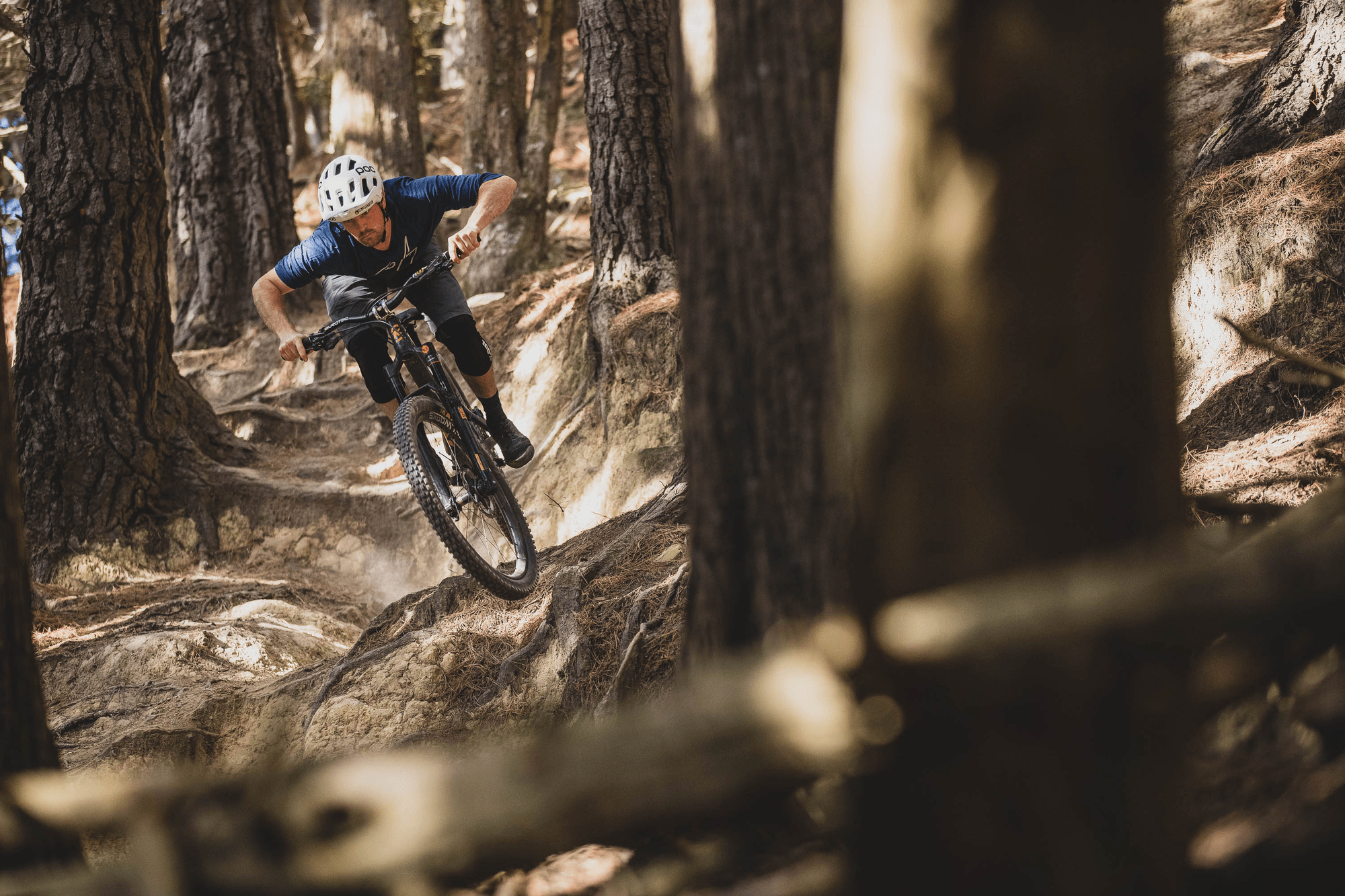
One of my biggest pet peeves is knee pads that slip down during a crash. There is nothing worse than buying a new set of knee pads you're stoked on, only for them to slip down your leg during a tumble, doing nothing to protect your knee. It's the worst. So, where does the 100% Teratec plus come in? Well, with a massive silicone webbing covering the inside cuffs on the top and bottom of the pad, these pads stay in place even after the biggest rags. The Teratec Plus work on a tight fit versus straps. This style of tight fitting pad can be hard to put on sometimes, but 100% have been smart and added a small hand pocket/handle for helping you pull the pads up. On top of the small pocket, and around the guard itself, is a thin layer of padding which just adds a little extra protection.
I’ve been using the Teratec Plus as my daily pads for the last few months. They have been on all sorts of adventures and rides, from big hike-a-bike days in the back country to quick loops of my local trails in all sorts of different weather: wet, dry, hot or cold. I went for the medium size as it's the size I normally choose when going for knee pads. Over the first couple of rides they felt a bit tight - the big silicone cuffs caused a bit of uncomfortable friction on my lower thighs. After a few rides, though, they stretched out slightly and the friction disappeared. This seems to be a common theme with compression-fit pads.
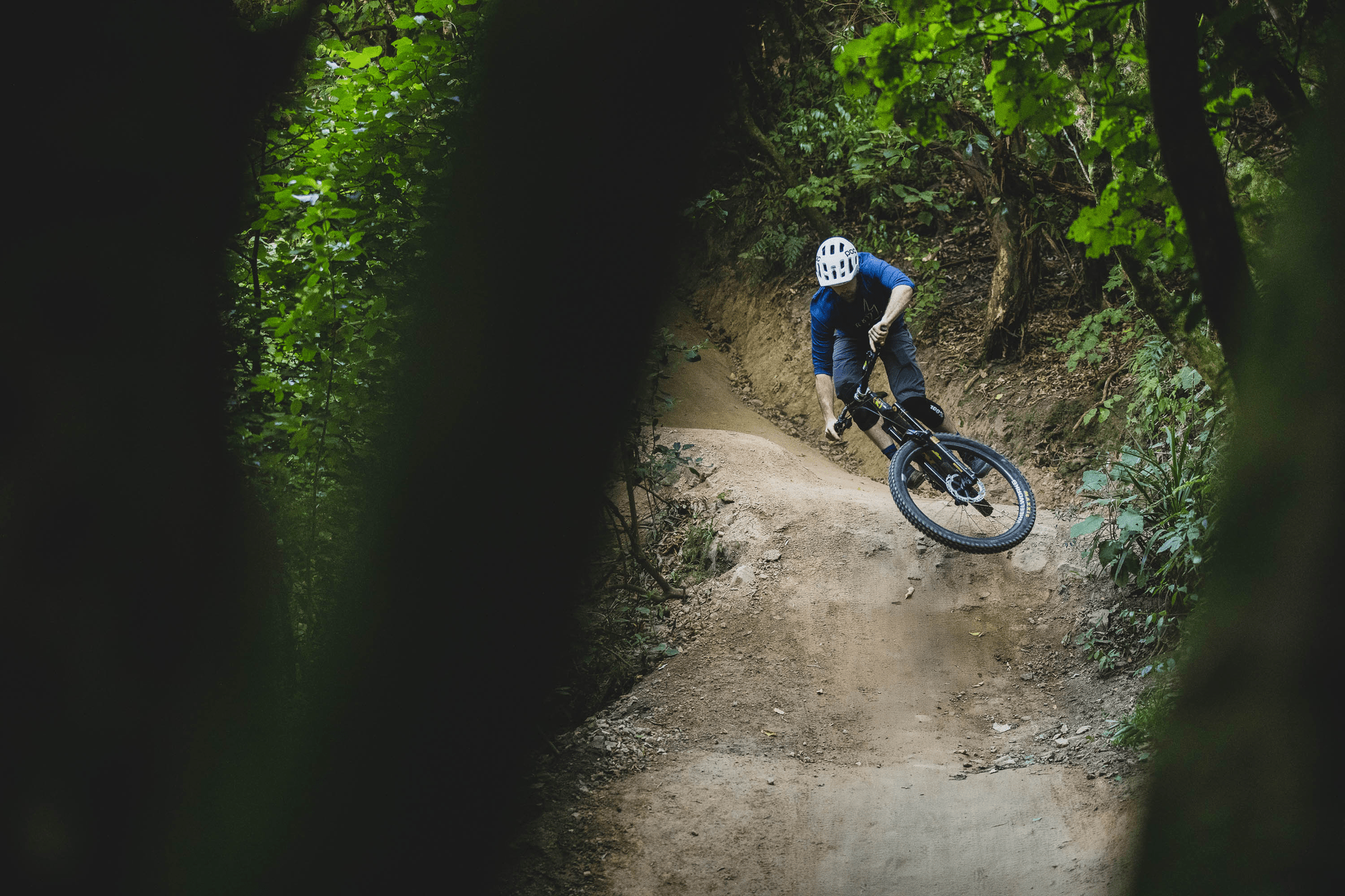
The Teratec Plus is aimed at the Enduro end of the spectrum, promising ‘Level 1 Protection’ in a pad you can pedal all day in. I can definitely say that both these claims are true - the protection level certainly lives up to the marketing hype. I've had some massive rags with these pads on and come out the other side with only a bruised ego. I'm a really big fan of the extra bits of pad they have added around the actual knee protector, as these help with awkward little bumps that can hurt a lot more that they should - funny bone knocks but in your knee. The ventilated mesh around the back of the pads do a good job of keeping you cool, but they still run a little hot in comparison to a lot of the lighter weight pads. You can kind of notice the knee pads when you first put them on, but after about half an hour of pedalling you forget you’re even wearing them. They are low enough profile that they easily fit under your shorts, and are long enough that you don't get the dreaded twat gap. They are a good length over all, covering the area you are most likely to hit in the event of a crash.
Over all, I would say 100% Teratec Plus Knee Guards are the best pads I've used in the last few years. Offering great protection, you can ride all day in them if you don't mind a slightly hot knee, with the main thing being that they don't slip down in the event of a crash. I would happily ride laps of the bike park with these on, then head off on a three hour pedal in full confidence that if I have a crash, my knees are probably going to be fine.
Distributor: FE Sports
Words: Liam Friary
Film: Vanzacs and the Zoo Boys
The Vanzacs is a small group of mates from Australia and New Zealand that wanted to take on the world and get away with it by the skin of their teeth. The Vanzacs and The Zoo Boys take an inside look at one of the most notorious crews in mountain biking and how they succeeded as professional riders and racers while never losing sight of the need to have fun along the way.
Story: Bosch's 'e' Evolution
Bosch’s ‘e’ Evolution
The visionary Robert Bosch always appreciated the advantages of the bicycle. From 1890 onwards, the Bosch company founder visited his customers in Stuttgart on a modern “low bicycle”, which was still little-known in Germany - penny-farthings were fashionable in continental Europe at the time. Robert Bosch relied on technology that he considered to be future-proof and forward-looking. In 1923, Bosch introduced to the market a dynamo light for bicycles - it comprised a generator and a headlamp, with over 20 million units produced into the 1960s.
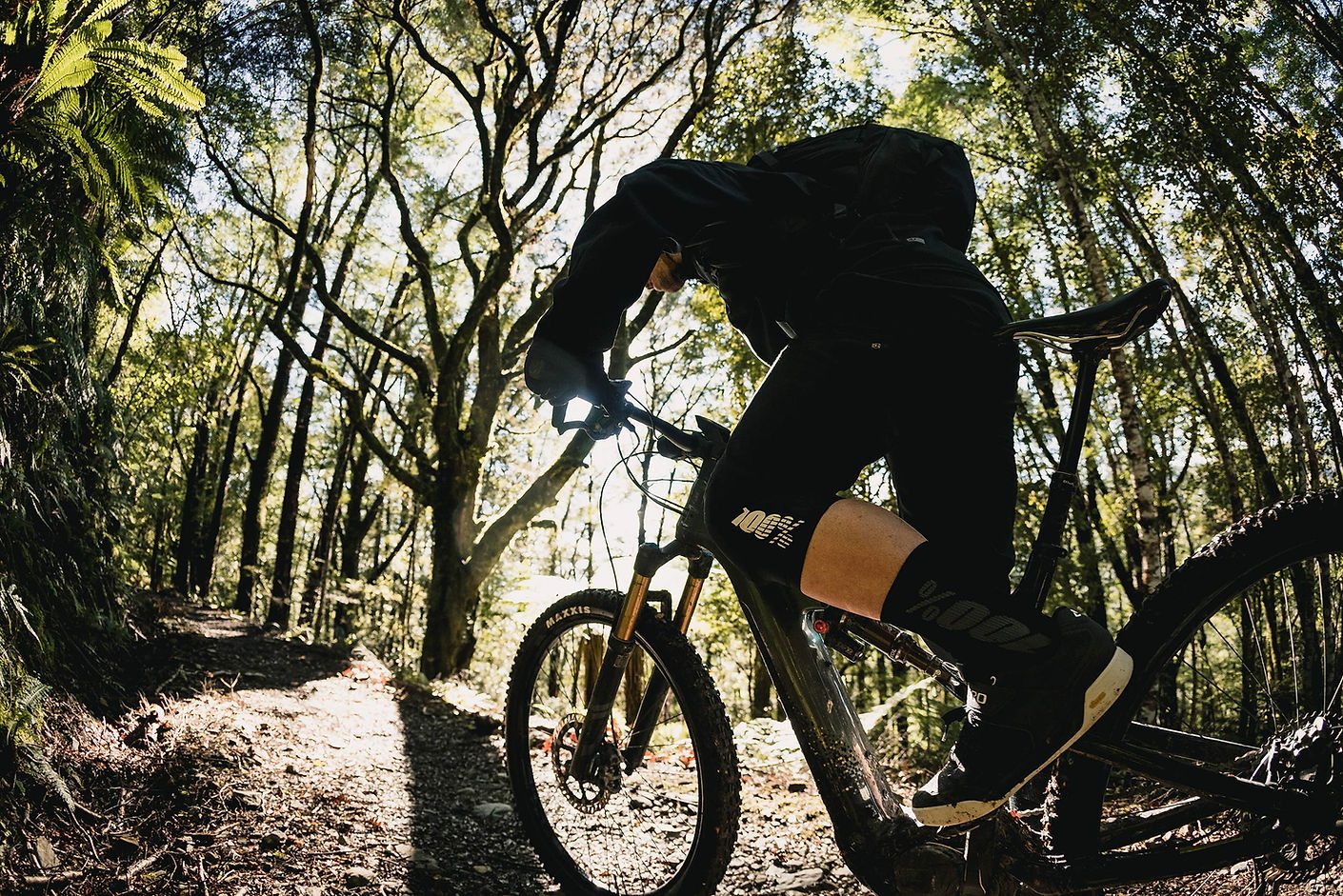
Fast forward to 2009, the bicycle once again became a focus for the Bosch Group, this time in electrified form. In the last few years we’ve played, reviewed and ridden more and more Bosch powered eMTBs. We thought it was about time we reflected on their history as we mark our historic 100th issue. A few weeks back I caught up with Dave Howard, Head of eBike APAC at Bosch, based in Taiwan. We’ve met in person before, but this time it was across digital means for obvious reasons. In fact, he was based in China but recently Bosch have moved offices to Taiwan to get closer to the brands and the assemblers.
Dave explained; “Back in 2009, it was just a handful of guys. First it was a hybrid with Mercedes Benz - it was a bit of a Frankenstein.” Bosch was, and has always been, around service first - following in the footsteps of their automotive division. “We never thought eBikes would have this much success.” In 2011/12, serious production began around the commuter space but Bosch had nothing in mind about eMTB. It strangely enough came from Taiwan, some of the cycle industry wanted to adapt it into MTB. As the industry always wants to push forward, a prototype concept was brought about. The tinkering began and the adaption of electric to MTB’s was made. However, it was still a prototype and a long way off from being available on the market.”

A few years later, in 2014, the Bosch bicycle team was around 150 people. The business expanded for the global market. Bosch has staunch stance on supporting growth of OEM’s (Original Equipment Manufacturer) especially in North America. Of course the rest of the world matters, but North America is strategically important moving forward. At that time there was only handful of brands in the eMTB game.
Dave says; “IBD’s (Independent Bicycle Dealers) are the gatekeeper to the market and some of the IBDs sold throttle-based bikes without service. At that time there was push back from IMBA. Talk was about how these bikes would destroy our sales with ‘normal’ bikes. So, we needed to develop a strategy around this. It was a challenging time, there was a real stigma around it being lazy.”
When asked about our market, Dave says: “NZ was a surprise for Bosch as they were fast adopters, actually the market demanded Bosch came into the market sooner rather than later.” Bosch had to make moves quickly to keep up with the demand. “[A speed of] 32km per hour was a key thing and the importers asked Bosch to come into market. In NZ there were no barriers except getting product into the market.” I ask whether it will slow down? “Growth projection for NZ is starting to slow a little, however they predict around 13% growth over the coming years.”
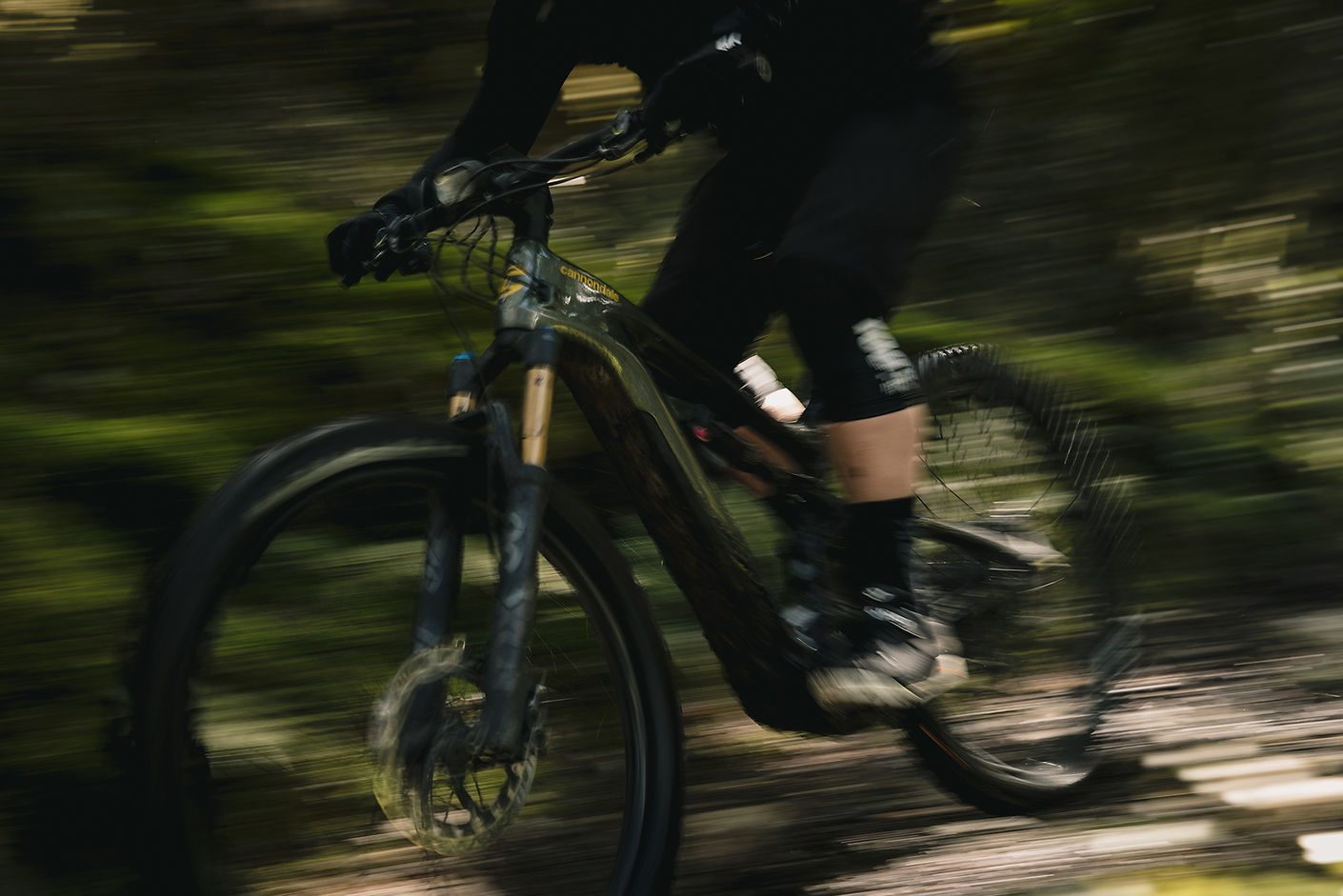
Over the years, Bosch has seen their eBike consumers change. The average user when they first launched was the Baby Boomer but, in more recent years, they’ve seen the age group drop down to the mid-thirties. It seems the trend is catching on. This is helped by their expanding portfolio of brands, rather than just being niche. Consumer perceptions are key and driven with top-end brands entering the category. In recent years, the smaller boutique/niche brands have adopted it, so in essence this makes it a more acceptable part of the mountain biking culture. Dave says, “it’s gone from niche to mainstream. There’s now an overpopulation of the category with a huge demand. It (eMTB growth) is supported by not only Bosch, but other brands that are driving the scene.”
Moving to the current decade, the eBike division at Bosch has expanded to around 500 people, and Bosch has around 70 brands using their product. Dave explains, “the aim is to have a team that’s small and agile.” Well, with a year most won’t forget, the adaptability of any business will be the key to future prosperity. I ask about what the future holds for eBikes? “Light eMTB will be the key; high-end bikes will remain but there’s a key to getting more people on bikes and involved with the sport. Design integration of battery and drive unit together. This is why we built a purpose-built drive unit so it could be a proper feel. There’ll be more innovating and refinements.” However, I want to know if they can extend the range of the batteries, as this catch up was just after our Old Ghost Road escapade (story in this issue), where we ran out of range. “There are limitations with batteries, if you increase the range then you need a bigger size and it’s a challenge with frame designs. If you want more range, then you need more space.” Back to the topic of the future. “Pre COVID 19 it (the future) was bright, and post it’s blinding, but we will need to step forward with caution. eMTB’s will continue grow, especially as the brands we all know and love have more offerings within the category. We aspire to have a more natural feel and for the bike not to feel like a powered bike. The future is a super clean handlebar set up. We will continue to promote trail building and development.”
Words: Liam Friary
Images: Cameron Mackenzie


